Two Weeks in Italy: A Perfect Itinerary for First Timers
There’s a good reason why Italy tops the bucket list of countless travelers. It has a unique historical significance (even though Italy itself is actually one of the youngest countries in Europe) thanks to the Roman Empire’s escapades, it has a famous food culture (not to mention the wine), and it has gorgeous scenery.
Italy has spent hundreds of years building its brand which has millions of people dreaming of visiting Italy.
But as we’ve learned over the course of our time in Italy over the past two years (almost two months in total), boiling the entirety of Italy down to just a handful of things it’s famous for means that you’re missing the things that really make Italy special.
Coming from an American perspective, we have a very specific view of what it means to be “Italian” that involves numerous stereotypes including some combination of chicken parmigiana, garlic bread, and talking with your hands (in our experience, only one of those is genuinely found in Italy – which one is it?).
However, after several trips where we’ve been able to go a level deeper than you usually do on that first trip, we’ve come to realize something important.
Italy is a surprisingly diverse country.
Not necessarily in terms of race or ethnicity, which is how the word “diversity” often gets translated, but in terms of regional differences that have been formed over thousands of years.
The regional differences in culture, dialect, and cuisine that come from centuries spent as independent (and often warring) city states are what we love about Italy, and that diversity is what makes Italy a fascinating place to visit.
As you move between regions, you’ll notice that the food and wine menus change drastically, as do the accents and cultural norms.
With so much to learn, see, eat, and drink in Italy, how do you even go about planning a trip to Italy?
In this guide to planning your trip to Italy, you’ll find a detailed two week itinerary, complete with things to do, see, eat, and drink.
Plus, the important details you need to know like how to get around, the best way to experience the Colosseum, and the best way to tackle the beast that is the Vatican Museums.
We’re going to give you our version of the best way to spend two weeks in Italy (for the first time) all based on our own experiences over the course of multiple trips over the past few years (four trips in five years, at the time of writing).
As you can pretty clearly see, we can’t get enough Italy in our lives.
In this guide to planning a memorable 14 day trip to Italy, here’s what we’re going to cover:
- Exactly how to plan out your trip, including what stops to make, what route to take, and all the important logistics you need to know
- A guide to what to do, where to stay, and how to get there for each stop on the itinerary
- Options for shorter and longer trips if you have more or less time in Italy
This itinerary covers Italy’s major cities – Rome, Florence, and Venice – along with some time spent in less heralded places like Bologna that most tourists miss, but we believe is well worth a stop.
Throughout the guide, we’ll share our favorite finds and experiences in Italy based on our multiple trips to help you plan your unforgettable trip.
Sound good to you? Let’s get into it.
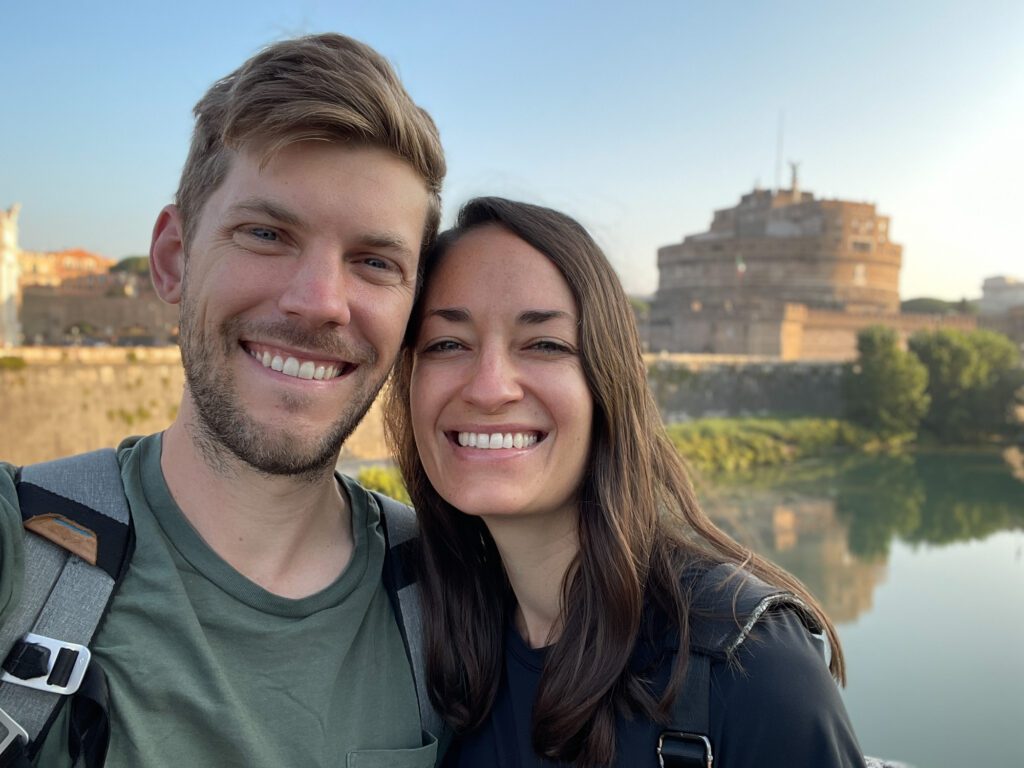
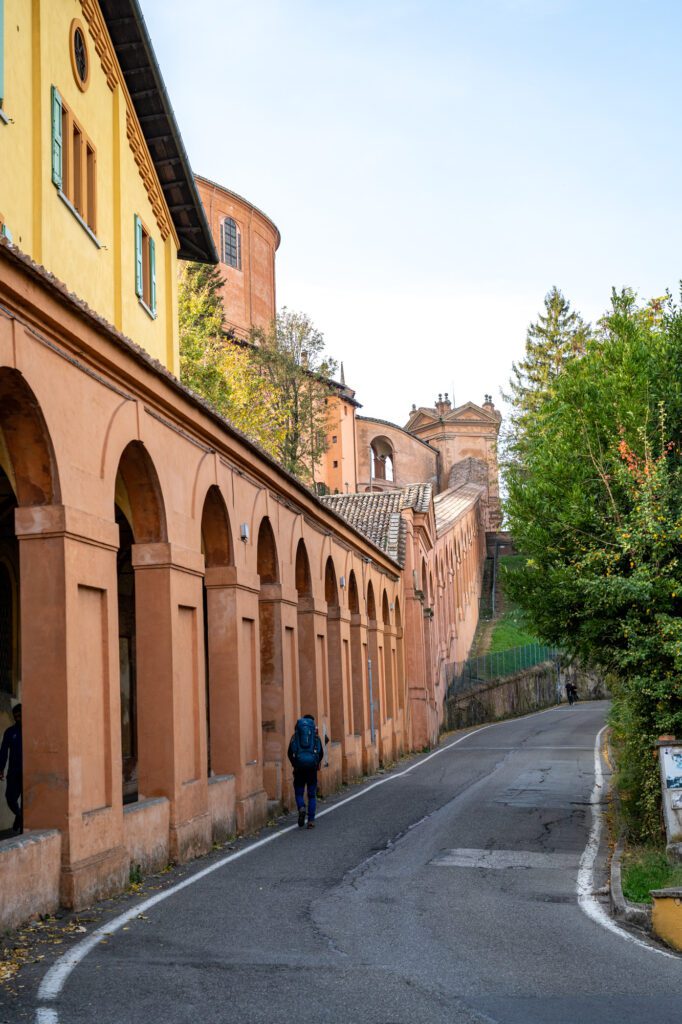
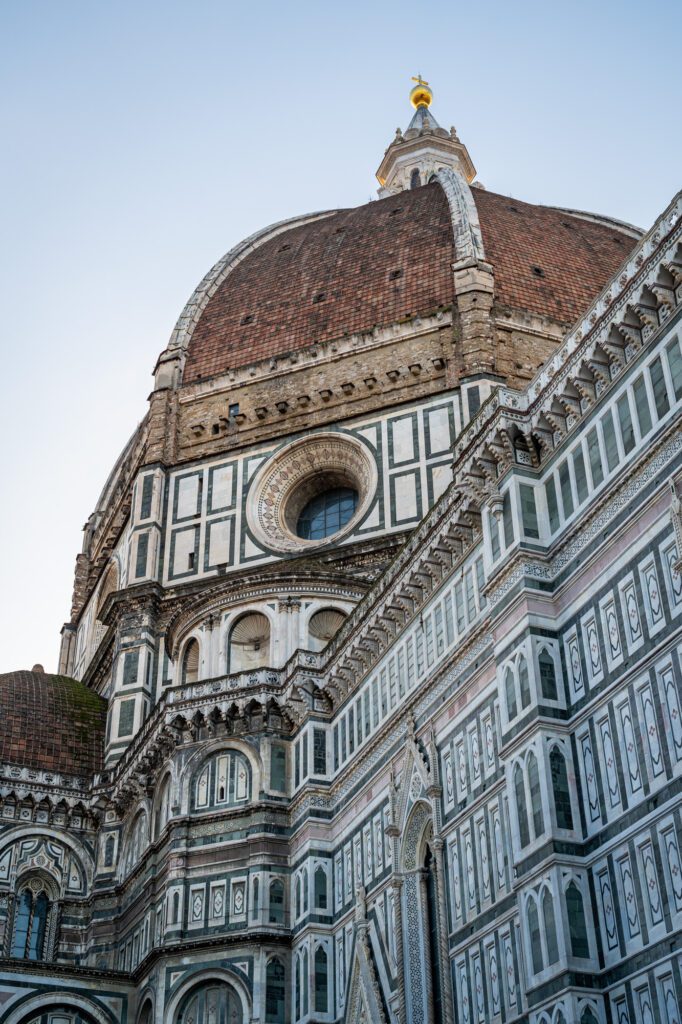
Disclaimer: Some of the links in this post, like hotel links, are affiliate links, meaning at no additional cost to you, we make a little bit of money if you click through and book. That being said, we would never recommend something to you that we don’t stand behind 100%.
What Can You See with Two Weeks?
Is two weeks enough time to see the entirety of the boot-shaped peninsula?
In short, no. Definitely not.
However, we do think it’s a good amount of time to see a chunk of the country that will give you a nice overview and help you decide where you want to dive deeper on your next trip.
In this itinerary – which is primarily designed for first timers – we’re going to cover both the main cities (Rome, Florence, and Venice) and some of our favorite places that don’t usually make the list (Bologna and Verona).
P.S. If you have a shorter trip, make sure to check out our guide to 10 days in Italy, which focuses on Rome, Florence (and the surrounding area), and Venice, or our guide to spending a week in Italy, which has five ideas for a week in Italy that you can mix and match to build your own itinerary.
There are two places that you won’t find in this itinerary for various reasons.
First is southern Italy – specifically Napoli, Pompeii, and the Amalfi Coast.
The reason is not that they aren’t beautiful or worth seeing, but that we think your time is better spent in northern Italy, which is our favorite part of the country.
Getting between Napoli and northern Italy is going to take a lot of time that would be better spent exploring!
The second place is the Cinque Terre, and it’s for a similar reason. The Cinque Terre is gorgeous. But it’s not particularly easy to get to.
You’ll need to make multiple connections from Florence, and it’s going to take about three hours each way.
If you do want to add the Cinque Terre, you’ll need at least two full days. We have some ideas on how to add it below the main itinerary.
If you’re interested in visiting Cinque Terre, make sure to read our guides for Cinque Terre.
Where to Start and End Your Trip to Italy
The next thing to think about as you’re planning your trip is where you’re going to start and end your trip to Italy.
The first thing to know is that, if you can, you should book an “open jaw” flight – a flight that arrives in one city and departs from another – to cut down on backtracking and extra travel time.
We’ve organized the itinerary below to travel from Rome to Venice (with several stops along the way), which takes you on a tour-de-Italy from Rome to Venice, you’ll want to fly into Rome–Fiumicino International Airport (FCO) and out of Venice Marco Polo Airport (VCE).
Both are big international airports, but will likely require a connection if you’re coming from outside of Europe (usually that connection will be London, Amsterdam, Paris, or Frankfurt, but it depends on the airline).
The other good international airports in Italy are in Milan, where there are actually two options, Malapensa (MXP) and Linate (LIN).
Getting Around Once You’re In Italy
The best way to get around Italy is by train. At least for your purposes on the itinerary below.
It’s going to be cheaper, faster (once you include travel time and security at the airport), and better for the planet than hopping on a short flight.
There are a few things you should know about trains in Italy before we get any further.
First, there are (essentially) two types of trains in Italy – high speed and regional – and they operate differently.
High speed trains are more expensive, significantly faster, and less flexible. To save time since you’ve only got a limited amount of it in Italy, you’ll want to take the high speed trains between cities.
You’ll want to book your ticket as far in advance as possible, which usually will save you some money, but will be less flexible. If you want the flexibility, you’ll have to be prepared to pay a little extra.
Regional trains are slower, cheaper, and more flexible. They’re usually for connecting nearby smaller cities to each other (for example, there’s a regional train between Florence and Pisa).
You can buy these tickets when you arrive at the station, and they’re more flexible. You need to make sure you validate them before boarding.
The best way to book train tickets in Italy is directly through Trenitalia, the company that runs most of the trains in Italy. The only downside is that you’ll need to know the name of the station you want to travel to in Italian.
We’d take high speed trains between Rome and Florence, Florence and Bologna, Bologna and Verona, and Verona and Venice. For day trips from Florence and Bologna, regional trains will do.
P.S. We have an entire guide full of tips for visiting Italy for the first time that we’ve compiled over our time in Italy that covers itinerary planning, logistics, and cultural differences. We think you should read it to make your trip smoother and more have a more immersive experience.
Should You Rent a Car in Italy?
For context, we almost never rent a car in Italy, and generally exclusively use the train network. And we always have a lovely time exploring the country.
You definitely won’t need a car in any of the cities. Aside from the stress of driving in a new place, navigating Italian traffic (and drivers), most big cities have a “ZTL” that you can’t enter without a specific permit. Violations – policed by camera – come with a hefty fine.
A car will almost certainly be more of a hindrance than a help in the cities, and the day trips we recommend are very easily accessible using the train.
However, there are a couple of places where a car might be useful, and they’re add-ons to the main itinerary that we’d only recommend with more than two weeks.
If you’re planning on going deeper into Tuscany (like the Val d’Orcia, Chianti, or San Gimignano), then a car will probably be useful. The same can be said of Sicily (though it depends on what part of Sicily you visit).
Check prices and book on AutoEurope, which is our go-to rental car company in Europe. We used them twice on our three month European adventure – including in Sicily – and it was perfect both times.
A Perfect Two Week Itinerary for First Timers
And now, on to the detailed itinerary.
Here’s how we would plan a trip to see the best of Italy over the course of two weeks, starting in Rome and ending in Venice:
- Day 1: Arrive in Rome
- Day 2: Rome
- Day 3: Rome
- Day 4: Rome + Train to Florence
- Day 5: Florence
- Day 6: Florence
- Day 7: Florence Day Trip
- Day 8: Train to Bologna
- Day 9: Bologna
- Day 10: Day Trip to Verona
- Day 11: Train to Venice
- Day 12: Venice
- Day 13: Venice
- Day 14: Venice + Fly Home
One quick note: In general, when you’re moving between cities, we’d recommend taking an afternoon train, which will give you some extra time to explore the city you’re leaving in the morning before heading to the train station.
You’ll notice a couple of different things about the way we’ve structured this itinerary.
First, we’re big fans of spending at least 2-3 days in big cities to avoid feeling like you’re rushing around from sight to sight. That will give you some time to do some exploring to find a new favorite neighborhood, coffee shop, wine bar, or restaurant.
Second, we hate packing and moving accommodations. It sucks. Which is the reason we’re recommending you stay in a place like Florence or Bologna and use it as a home base for exploring the surrounding area.
Third, we’ve included a significant chunk of time in Bologna. Which is our favorite city in Italy not named Rome or Florence (Lucca and Verona are also in the running).
Here’s why: Bologna is the capital of the best food region in Italy, home to the production of delicious things like Parmesan-Reggiano cheese (we LOVED touring a small producer of Parmigiano-Reggiano with Claudio on this tour), prosciutto di Parma, mortadella, balsamic vinegar, Lambrusco (a sparkling red wine), tortellini, ragu, and plenty more.
Not only is the food incredible, but the city – which feels noticeably younger and less “touristy” than most of the cities here – is a nice change of pace from places like Rome, Florence, and Venice.
Bologna also makes an excellent home base for day trips because it is so well connected.
Whatever you do, we’d implore you NOT to cut Bologna. It’s an amazing city, and you won’t regret spending a day or two there.
Fourth, it might seem like a lot of time in Venice at the end. However, it’s really only two and a half days if you take a midday train there, and have an early flight home.
If you have a full 14 days in Italy (you’re flying out on day 15, for example), we’d add an extra day either in Florence to do another day trip, or in Rome.
For each place, we’ll go a little deeper than a short description and give you some of our favorite things to do, see, eat, and drink that come from our own experiences exploring Italy (and, equally crucially, what not to do – looking at you, Juliet’s House in Verona!).
We believe those details – like specific wine bars, tours, and coffee shops we loved – are the difference between a good trip and an incredible trip, and hope you’ll find a few places that you wouldn’t have necessarily found on your own.
The other intention here is to not just give you the same old itinerary that you’ll see in every guidebook.
Of course, we’re going to include Rome, Florence, and Venice, because those are places that are absolutely worth seeing on your first trip to Italy.
However, we’re also going to include some of our favorite places (like Bologna) that don’t usually make the cut.
Rick Steves (who Matt loves – he’s from Seattle too!) doesn’t even include Bologna in his Italy guidebook! What a miss.
Days 1-3: Rome
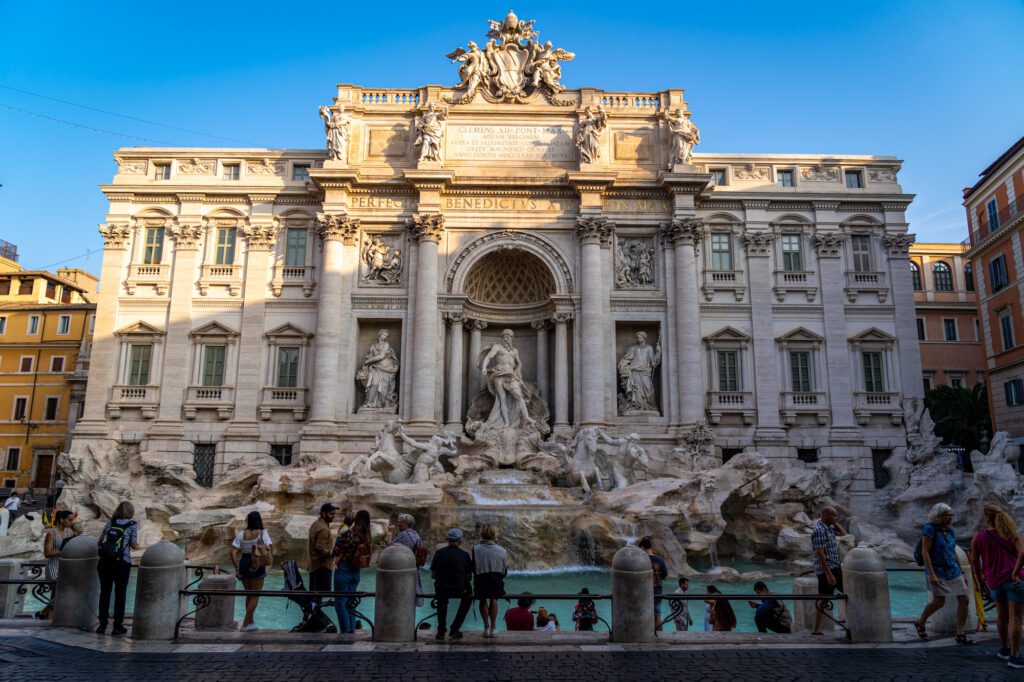
I mean, if you’ve never been to Rome before, you’re in for a treat.
Rome is one of our favorite cities in Europe, and there’s something special about walking past architecture from over a thousand years ago on your way to a hip natural wine bar in the evening.
While Rome is famous for its historical sights, it’s also a great city for food and drinks (as we’ll cover below) and as I’m sitting here writing this, I literally made a Roman pasta dish (amatriciana) for dinner last night.
We’d recommend three days in Rome, at a minimum, which will allow you enough time to see both of the main attractions, dive into the history of Italy’s capital city, and also indulge in some of Rome’s great food and drinks.
What to Do in Rome
One of the most important tips we can possibly give you for Rome – though it’s also relevant for just about any city in the world – is to avoid doing multiple big attractions on the same day.
Speaking as someone who, on a tight timeframe with my mom, tried to do both the Galleria dell’Accademia (home of the David) and the Uffizi Gallery in Florence on the same day, you will absolutely be exhausted by the second one, and you will get far less out of it.
Part of the reason why we have you spending a fair amount of time in Rome is to give you plenty of time to do the big sights – the Colosseum (and Roman Forum) and the Vatican Museums – on different days.
Obviously, Rome is a huge, complex, history-filled city, and there is plenty more to experience in it.
For more, we’d point you to our 4 day Rome itinerary and our guide to the best things to do in Rome (for first timers), which have all of our favorite things to do, see, eat, and drink in the Italian capital.
The Colosseum & Roman Forum
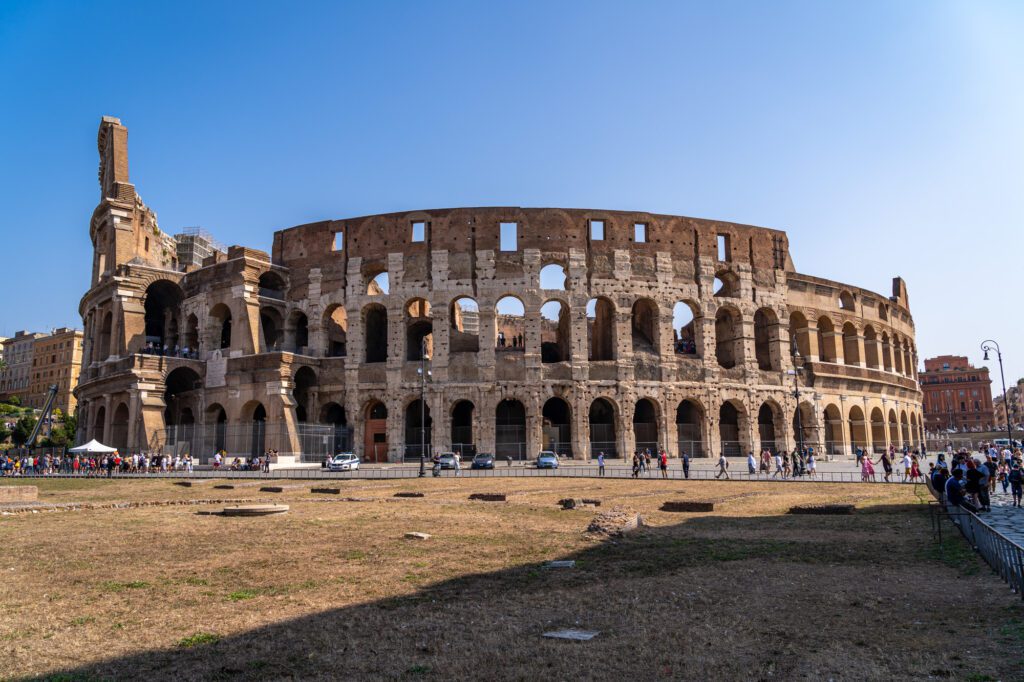
The Colosseum and Roman Forum are, perhaps, the greatest example of Rome’s gilded age.
At that point, Rome ruled the Mediterranean, transforming so many places in Europe and North Africa with their innovative technologies (you’ll see big arenas all over, in Spain and southern France, along with things like aqueducts), and created a political system that forms the foundation of so many modern countries.
You’re not going to want to miss it, and we’d plan on dedicating a half day exploring these two treasure troves of history.
First of all, we’d highly recommend heading to this garden early in the morning or late at night for an excellent view (and picture) of the Colosseum, and this viewpoint for a great view of the Forum from above. Both are completely free!
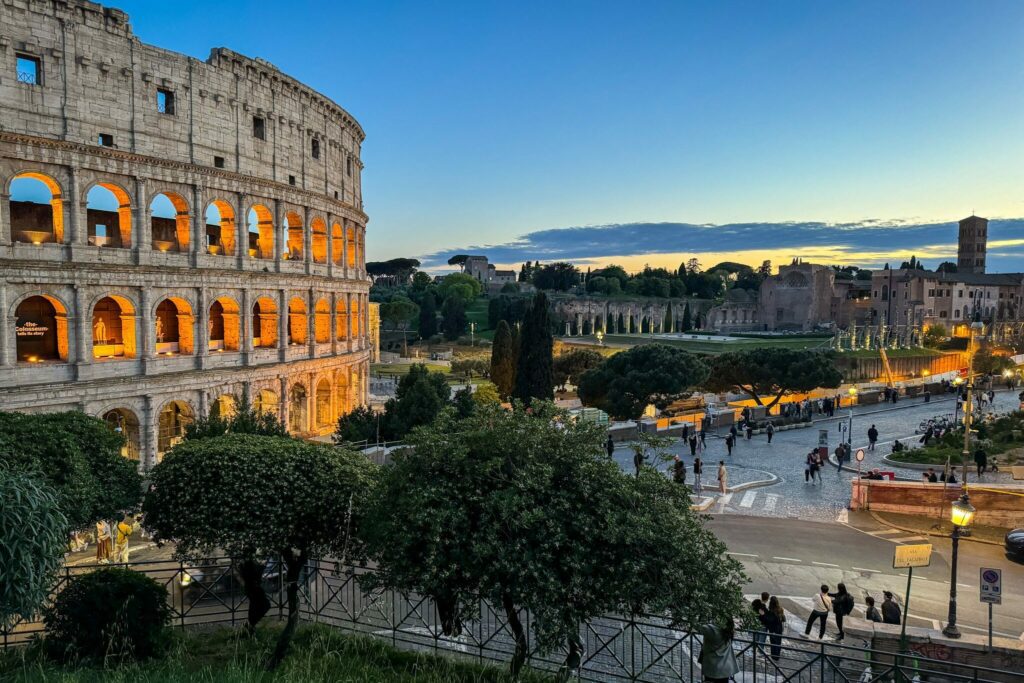
Second of all, if you find that you only have the time or budget for one guided tour in Rome, this should be it.
The reason for that recommendation is that, when you really boil it down, the Roman Forum is really just a bunch of crumbled buildings, and without the added context and history that a guide will bring, it’s hard to wrap your head around what exactly you’re seeing.
Coincidentally (or not so coincidentally), the guided tour that changed our perspective on whether or not tours are worth it was actually this Colosseum tour with Walks of Italy.
Before that tour, which shattered some of our misconceptions about the Colosseum and was both educational and entertaining, we were on the fence about whether tours were really worth the price.
After that tour, we were all in on guided tours, which give you an opportunity to connect with locals, gain a deeper understanding and context for what you’re looking at, and lead to a much richer travel experience, which is what we’re all here for (we think, anyway).
If you want to know more about that tour, you can read more about our experience on the Colosseum tour that changed our lives (hyperbole, but accurate).
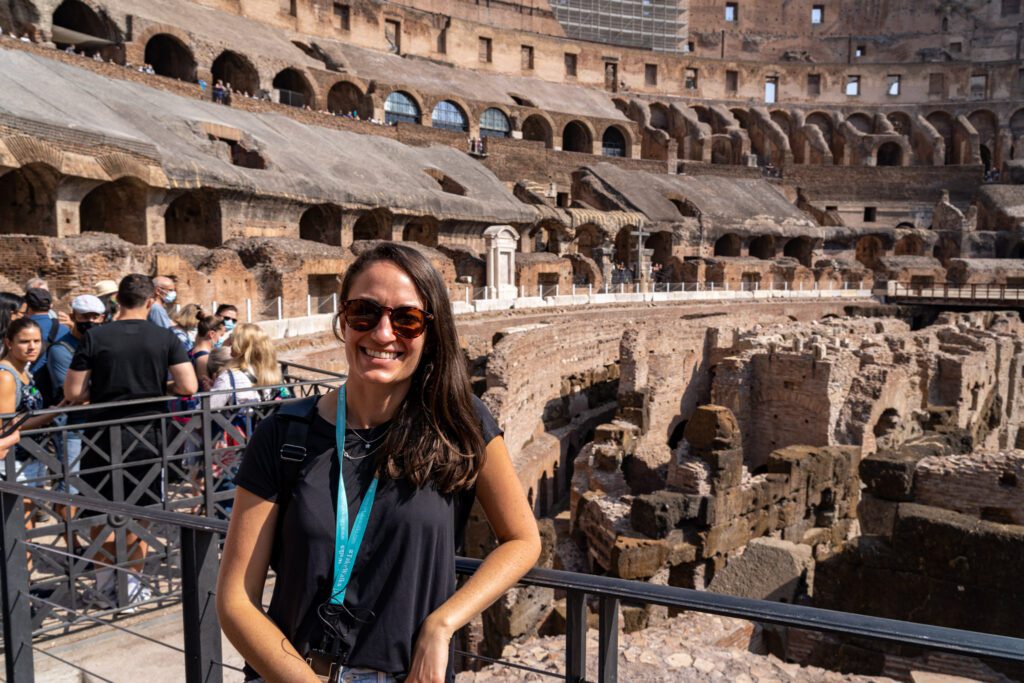
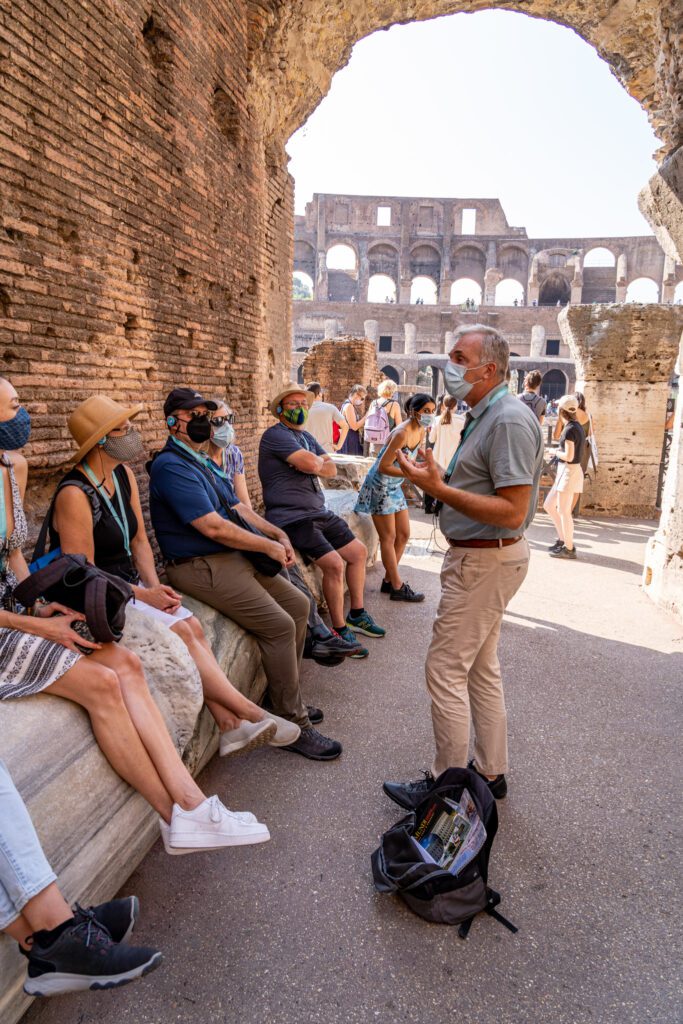
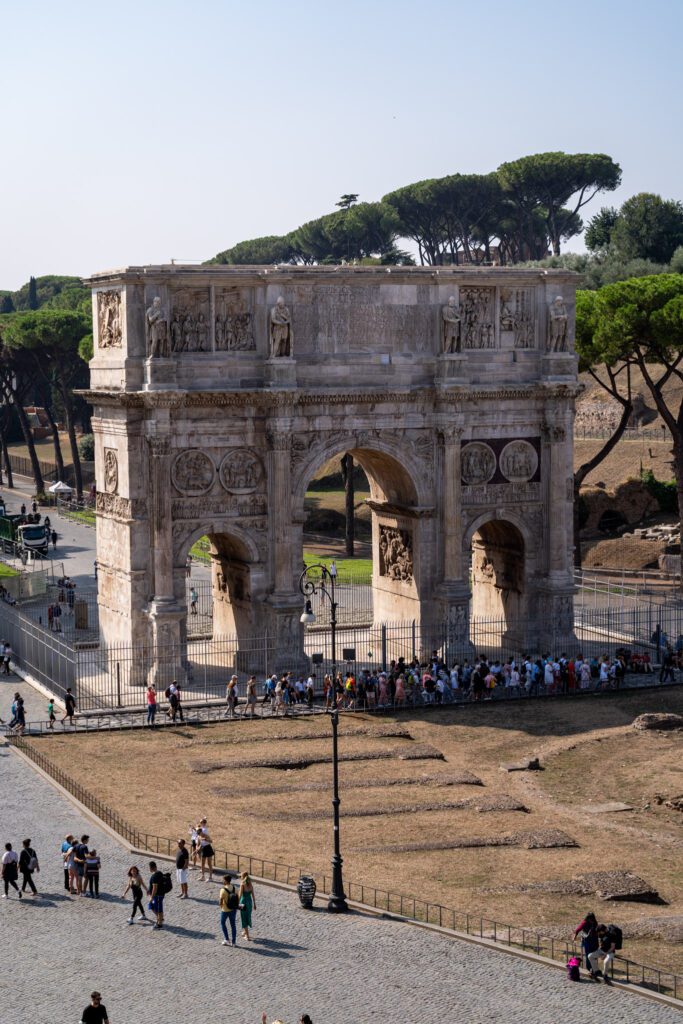
If you don’t want to do a tour, we have a couple of recommendations for you to make the most of your visit (and we have an entire guide dedicated to visiting the Colosseum, which you should read for ALL the details).
First, buy your tickets in advance – they go on sale a month in advance at the time of the tour (basically to the minute), and by a week or two out your options will be severely limited, especially if you want one of the add-ons, like the underground tour.
Here is the official ticketing website.
There are many, many ticket options available, with all sorts of added extras. The basic ticket is the “24h – Colosseum, Roman Forum, Palatine” for €18, which includes admission to both the Colosseum and Roman Forum (which have separate entrances) over 24 hours.
There are two main additions that you can add that might be worthwhile, depending on what you’re into.
First is the “Underground Levels,” which gives you access to the maze of tunnels under the arena floor that were used for staging the spectacles.
Second is the “Attic,” which gives you access to the top floor with great views of the arena.
You can only choose one, and they cost €24 (but give you access to the Forum for two days instead of one).
With any ticket, you will book your entrance time for the Colosseum, and then you will have the next 24 hours to do the Forum (we’d do them one after another, maybe with a quick snack or water break in between).
We’d do as early an entry as you can, because it does get HOT in the summer, and there is basically no shade. Another option would be one of the later timeslots, but it is still hot at 3pm.
We have an entire separate guide dedicated to visiting the Colosseum with all the important information you need to know – like what to see, how to get tickets, and the best time to visit – which you should read for far more detail than we have here.
The Vatican Museums & St. Peter’s Basilica
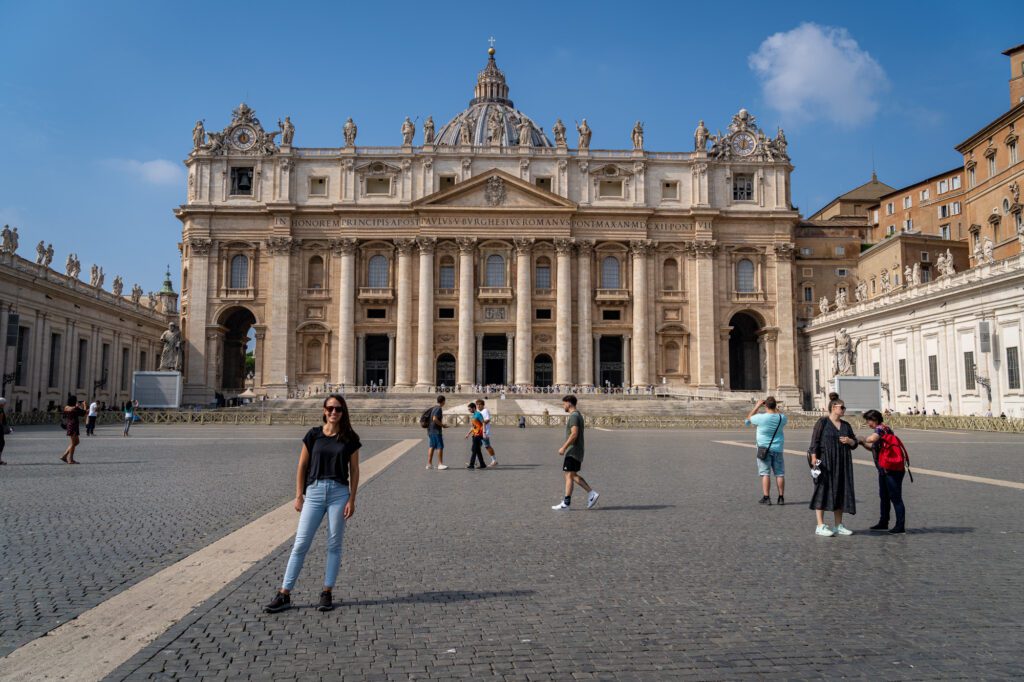
The Vatican Museums (which is where you’ll find the Sistine Chapel) and St. Peter’s Basilica are adjacent, but are two separate entry procedures, so we’re going to talk about them separately.
Our top tip for this (especially in 2025) is to do them on separate days so that you can enter both at the absolute earliest time slot you can secure.
We have an entire guide to visiting the Vatican with more details like the best time to visit, what to see, and how to buy tickets, which you should read as you’re planning your trip.
First of all, you’ll need to buy entry tickets for the Vatican Museums, while St. Peter’s Basilica is free to enter. For both, you’ll have to wait in the (sometimes long) security lines.
The Vatican Museums are home to an absolutely astounding collection of art put together by the Catholic church over centuries.
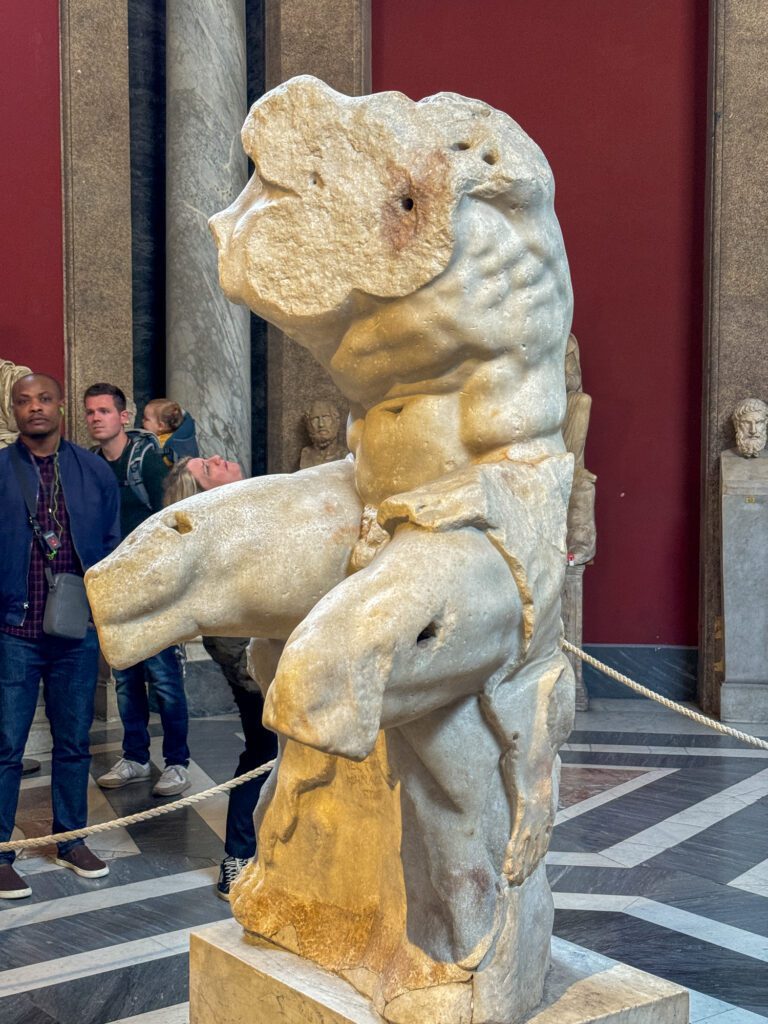
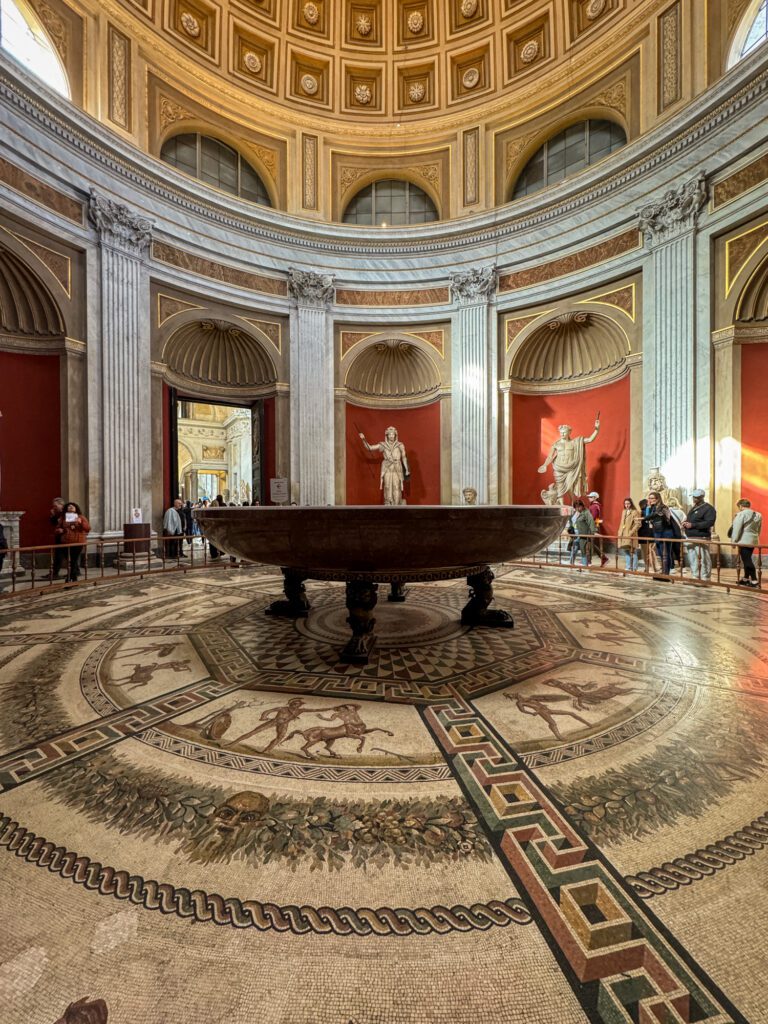
The Sistine Chapel is the crown jewel of the collection, we’d say, but there are so many sculptures, ornate maps, and various other works of art that are equally impressive to us (we love the hall of maps!).
The challenge with the Vatican Museums is that they are undoubtedly one of the most popular (and therefore busy) tourist attractions in Rome, in Italy, and quite possibly the world.
Like we said above, we’d strongly recommend an early morning entry if you can get it (though it’s competitive to get those).
A later afternoon entry time will also get you a quiet experience (my guide said usually the afternoon is even more quiet most days), though you’ll be limited by when the museum closes.
On a recent trip to Rome, I decided to revisit the Vatican Museums after skipping them on the past few visits.
I did the classic early morning “Pristine Sistine” tour with Walks of Italy, the same company who ran that life changing Colosseum tour, and very much enjoyed it.
However, due to changing rules and regulations with the Vatican, you should know that you are very much not alone in the Sistine Chapel anymore.
For that experience, you need to splurge on the Key Master’s Tour, which is significantly more expensive BUT has you literally unlocking the door to the chapel first thing in the morning, which is probably a once-in-a-lifetime experience that you won’t soon forget.
If the tour isn’t in the budget (or you would prefer to go at your own pace), this is another place that you should definitely buy tickets for in advance, especially during the summer.
Buy tickets here – toggle the site to English with the language selector in the top right.
They go on sale 60 days in advance, and sell out within an hour if it’s peak season. You want those early entry times!
For the best experience, we’d recommend picking the tickets that include an audio guide.
It’s a good middle ground between visiting independently and on a guided tour that gives you more information and context, but also allows you to move at your own pace.
For St. Peter’s Basilica, which is free to enter, we’d recommend going first thing in the morning when it opens (7am at the time of writing) to avoid the LONG security lines which wrap all the way around the square later in the day.
It’s free to enter, but you do need to wait in that line.
It’s also worth climbing the dome of the basilica, which is not free, which opens at 7:30am.
A few tips for visiting the Vatican Museums and St. Peter’s Basilica:
- It’s a lot of walking, including stairs. I clocked ~10,000 steps along the way, including several sets of stairs. If you have mobility restrictions, that might be a lot of moving around.
- You must cover your knees and shoulders inside St. Peter’s Basilica (it’s a Catholic church after all), so leave the short shorts and tank tops at home for this day, otherwise they will not allow you to enter.
- There is no photo or video allowed inside the Sistine Chapel. Yes, there are guards. No, you shouldn’t try to sneak a photo. Be respectful!
The view from the Orange Garden (Giardino degli Aranci)
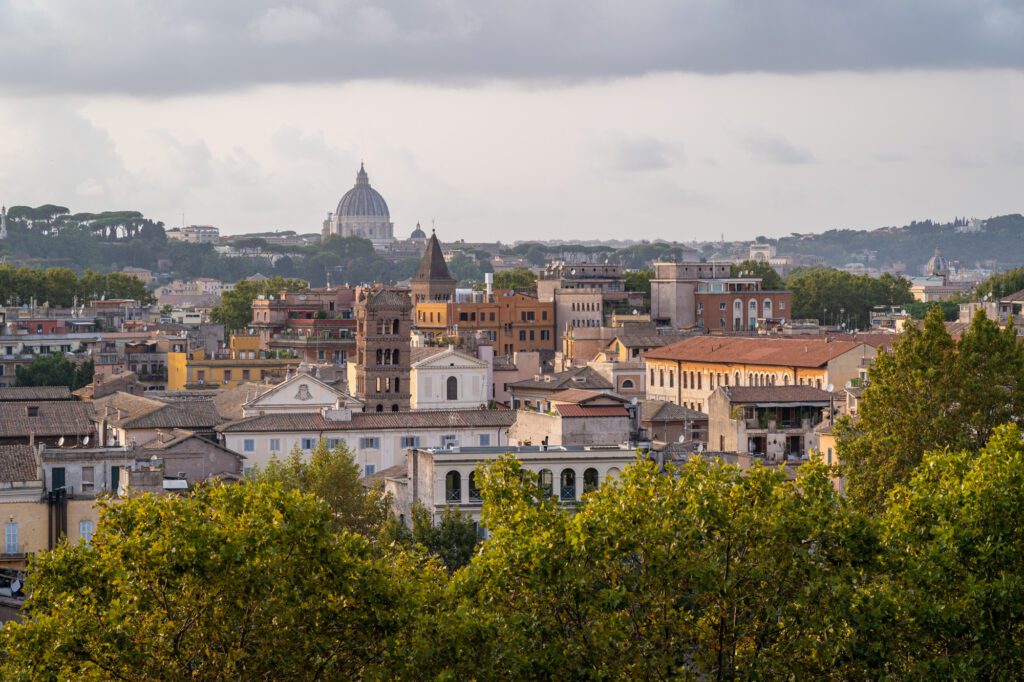
This is one of our favorite views in the city, and we’re not alone. Head up here around sunset for a treat, but it’s equally gorgeous in the early morning hours (perhaps better, because the sun is generally behind you), and there are far fewer people.
Experience the Magic that is Trastevere in the evening
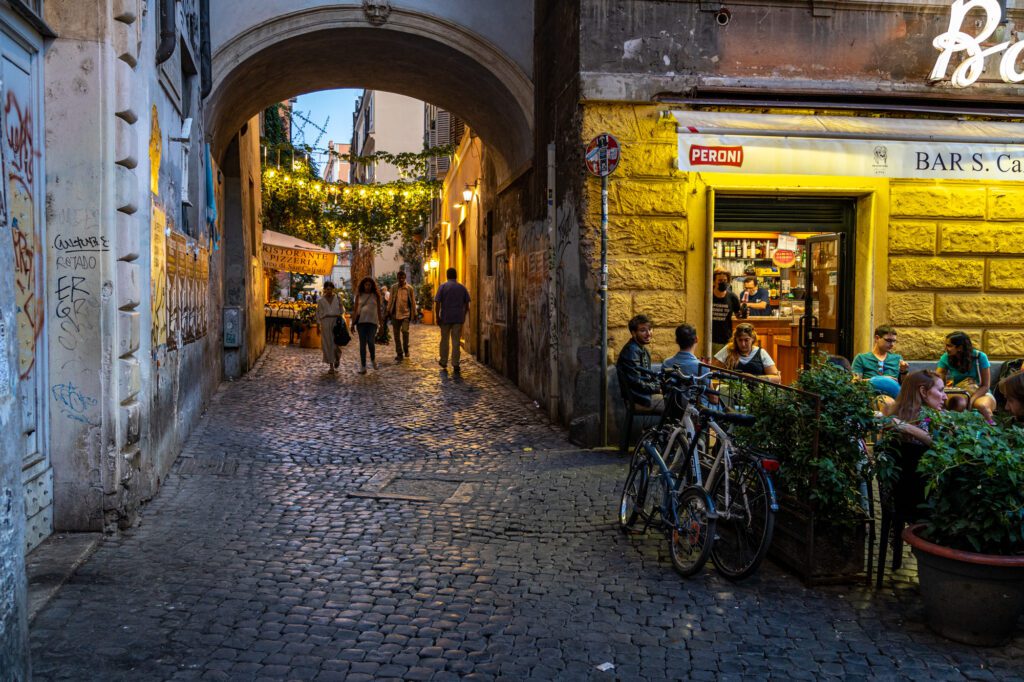
Our favorite neighborhood in Rome is Trastevere, and it’s not that close.
It’s nice in the morning, especially if you visit the open air market that takes place at Piazza de’ Renzi, but the evening is when it comes alive. People spill out of the bars and restaurants into the streets, and the piazzas are full of people drinking and being merry.
Drink Plenty of Italian Wine!
Enoteca il Piccolo in the Centro Storico (here it is on Google Maps) is as great as it is popular.
The owner came out to the terrace where I tried to explain in my bad Italian what kind of wine I wanted (dry white), and he walked away without a word, and returned with two excellent glasses of exactly what I asked for.
If you’re looking for a bottle, Les Vignerons in Trastevere is the place to go (great beer and cider selection, too!).
Explore Roman cuisine
First, we make the four Roman pastas at home (carbonara, gricia, amatriciana, and cacio e pepe) all the time. Roman food is generally very simple, but delicious.
The best way to learn about Roman food is taking a food tour with a local guide, where you’ll not only taste some delicious food, but learn about the history and context behind that food. Which is our favorite part about learning about food cultures of different places.
We’d do this tour, which looks truly spectacular and includes a lot of cultural context along with tons of tastings.
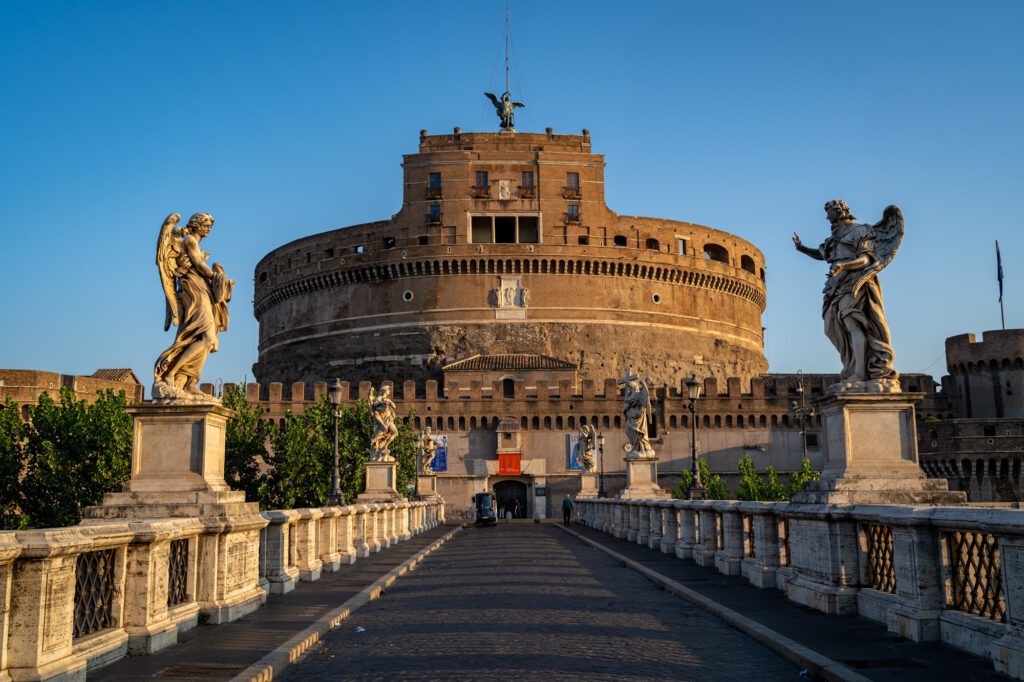
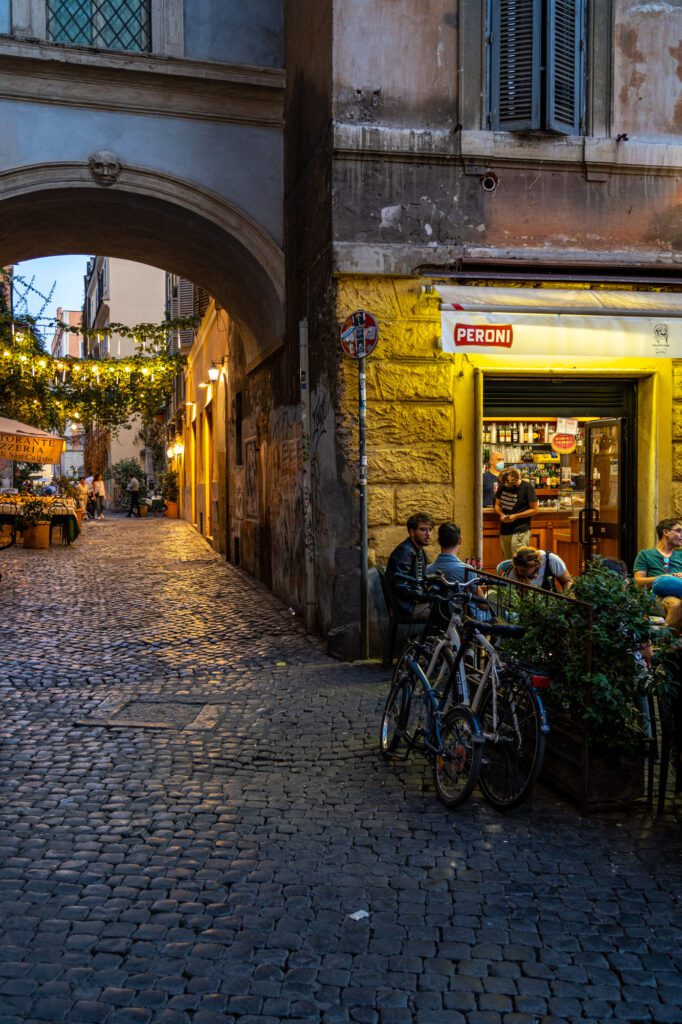
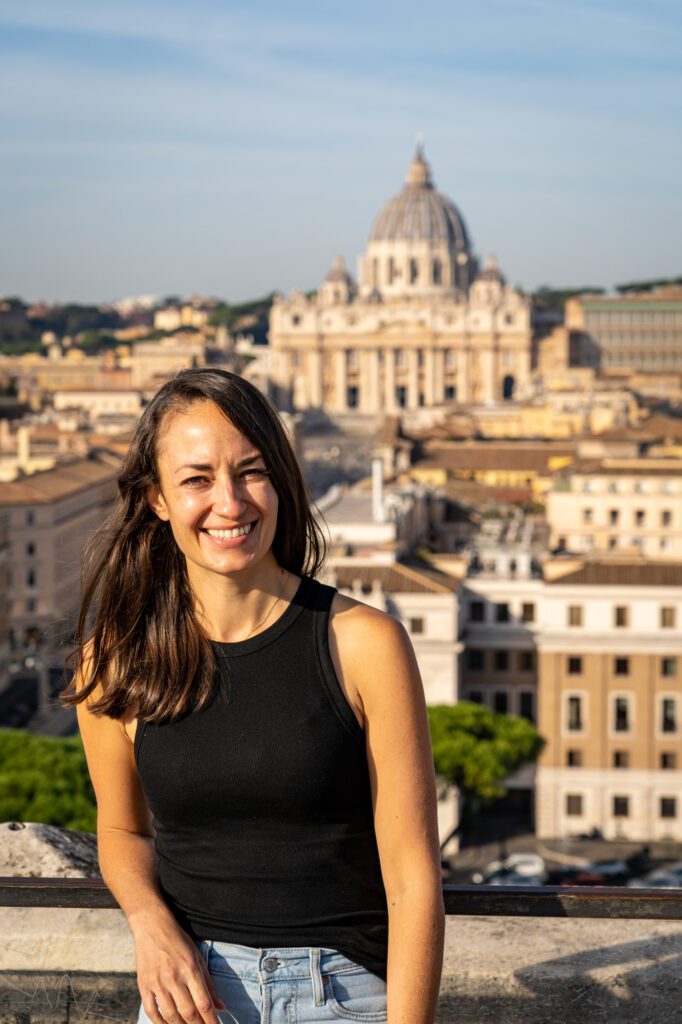
If you’re into good coffee, head straight to Pergamino Caffè near the Vatican, which is home to some of the best baristas in Rome who bring in a bunch of different Italian specialty coffee roasters to brew for you.
It’s my, Matt the coffee snob’s, favorite coffee in Rome.
Of course, there are tons of other things in the Eternal City that are worth doing, seeing, and eating. For more, head over to our guide to the best things to do in Rome, which has a collection of our favorites.
Where to Stay in Rome
While there are a bunch of areas you could stay in Rome, we have two strong recommendations for you to help you narrow it down.
We also have an entire, super detailed guide to where to stay in Rome if you want more details to make your decision.
Our overall recommendation is to stay in Trastevere, which is far and away our favorite part of the city.
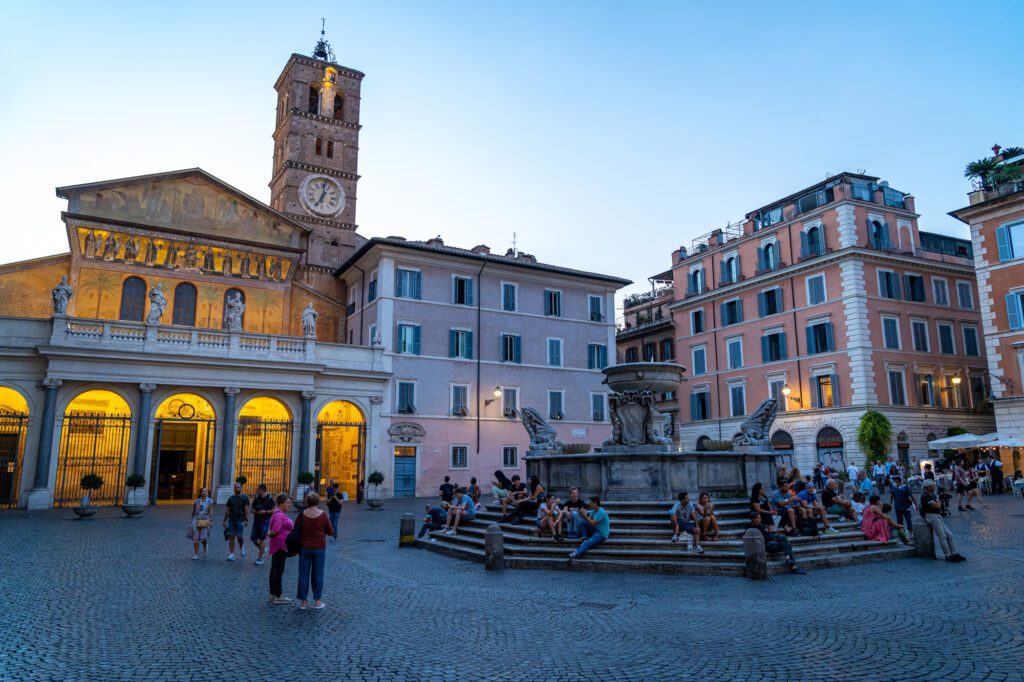
We stayed there on our last trip, and it’s magical.
It’s a great place to eat and drink, and it really comes alive when the sun goes down, full of lively piazzas and small bars and restaurants that fill up on a nightly basis and spill out into the cobblestone streets.
We stayed at Horti 14 Borgo, a small boutique hotel in Trastevere, and absolutely loved it.
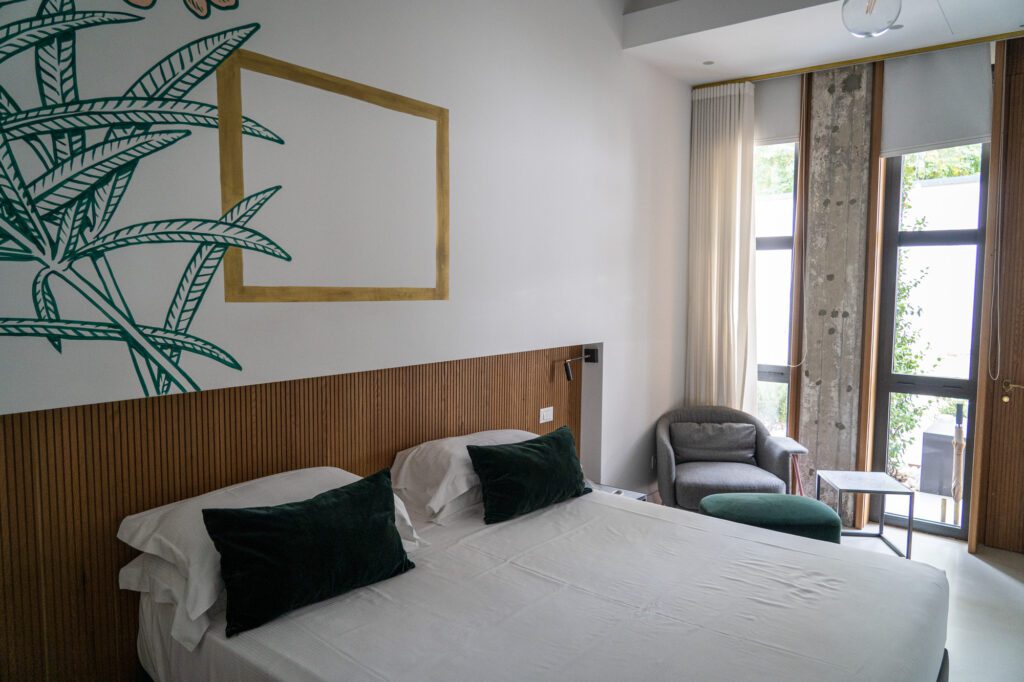
It’s a splurge compared to where we normally stay, but the stylish rooms, comfortable beds, and incredible breakfast buffet were worth it.
A more affordable (but equally highly rated) option would be Ripagrande a Trastevere, which is essentially right on the River Tiber and within five minutes of everything in Trastevere.
The only downside to Trastevere is the fact that it’s a little far from the train station, which doesn’t matter as much with three days, but is a little less convenient (you’ll need to take a taxi, most likely).
Which brings us to our second recommendation, which is Rome’s Historic Center (the Centro Storico).
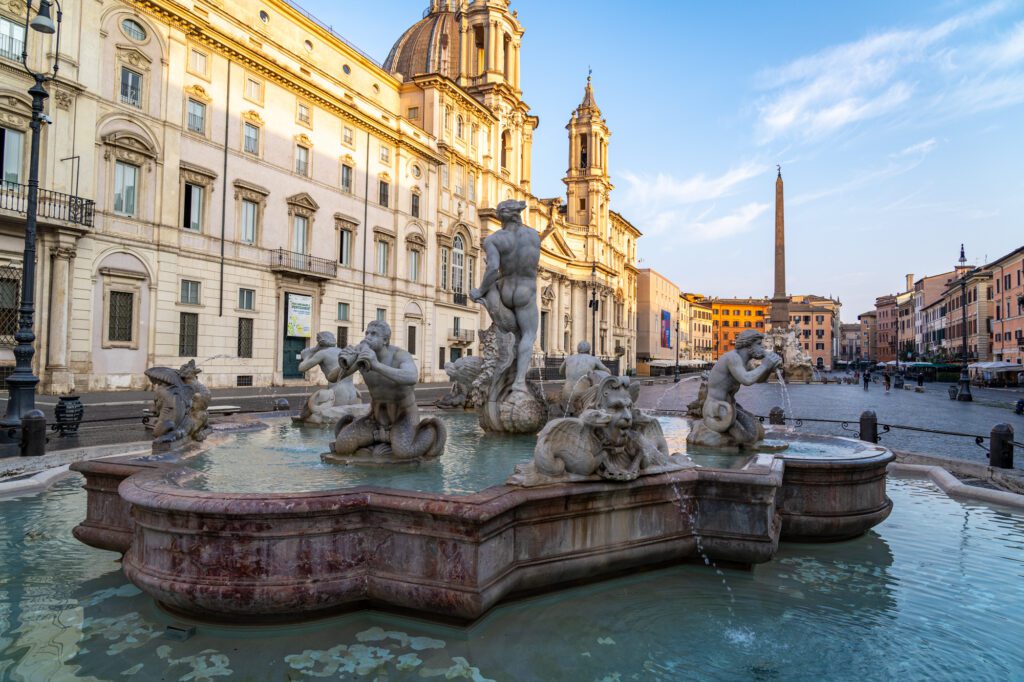
Stay here if you want to be right in the middle of all the action, within walking distance to just about everything in the city.
It’s the most convenient place to stay, though it will be crowded and potentially loud. Don’t miss an early morning walk from Piazza Navona to the Trevi Fountain and the Spanish Steps!
We stayed for five nights near Piazza Navona at these apartments, which were honestly a perfect location, especially if it’s your first time in Rome.
Coronari Palace and Casa Pietra are two hotels that were also on our list, though we decided we wanted more space and a kitchen for our time in Rome.
Days 4-6: Florence
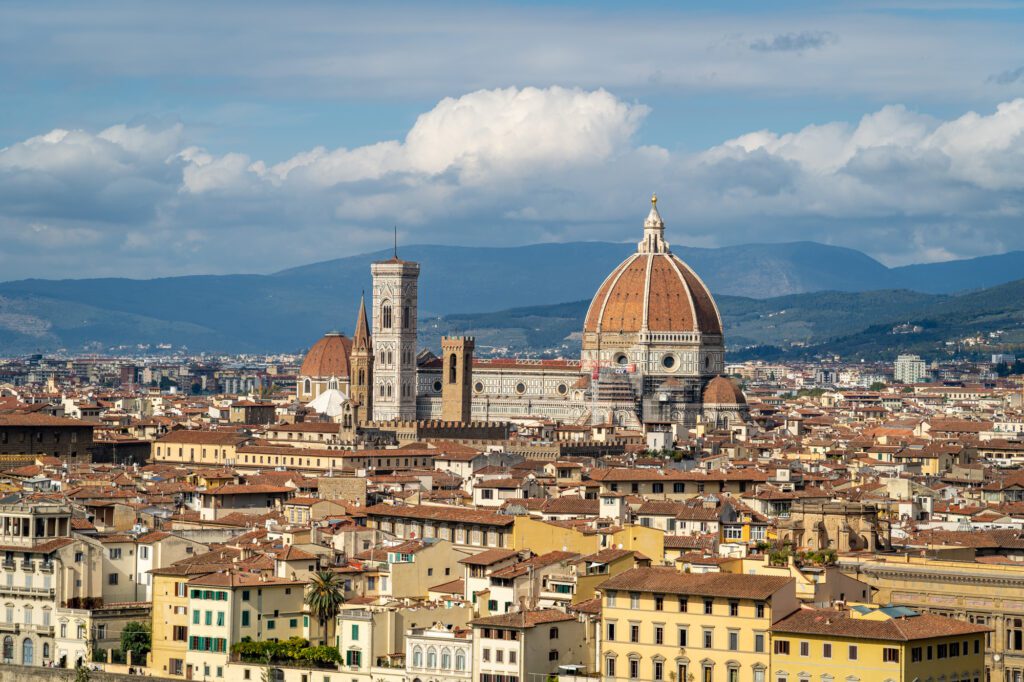
Historically, the city of Rome might be the crown jewel of the Roman Empire, but you could make a convincing argument that Florence is the second most important city in the history of the Italian peninsula because of its influence around the birth of the Renaissance.
On a walking tour in Florence (this one, which we recommend below because it’s a great introduction to the city), as we were walking through Piazza della Signoria, our guide made a point that I hadn’t really thought about before that moment.
Florence was one of the richest cities in Europe (if not the world) in the 15th Century and through the Renaissance.
A lot of people – myself included – might think that wealth came from the amazing art that was produced in Florence leading up to and during the Renaissance.
But the truth is that Florence was already a rich city thanks to silk production, and that wealth is what allowed it to become a cultural icon that thousands of people still flock to five centuries later.
Walking the streets of Florence, it’s easy to see why so many people fall head over heels in love with it on their visit.
It’s charming. The Duomo is incredible, both because of how imposing it is, and the fact that it’s an architectural miracle. There are two world class museums.
The food and wine are both excellent (definitely get the wild boar if you see it on a menu – pappardelle al cinghiale – which was our favorite discovery on our Tuscany road trip itinerary).
I could go on and on about Florence – I’ve spent over a week in Florence between two trips in the past year (at the time of writing) – but let’s leave it there and get into how to make the most of your time in the Tuscan capital.
In this itinerary, we have you spending two and a half days in Florence itself, and then using it as a home base for a day trip into Tuscany.
What to Do in Florence
In Florence, we think a couple of days is enough to see the highlights, and there are so many great possibilities when it comes to day trips from Florence that we think you should spend one of your days here outside of the city, experiencing a different slice of Italian life (and we have suggestions and opinions!).
Obviously, Florence is a cultural and historical gem, and there is plenty more to expereince.
For more, we’d point you to our 3 day Florence itinerary and our guide to the best things to do in Florence, which have all of our favorite things to do, see, eat, and drink in the Tuscan icon.
Here are a few of our favorite things to do and see in Florence.
The Uffizi Gallery
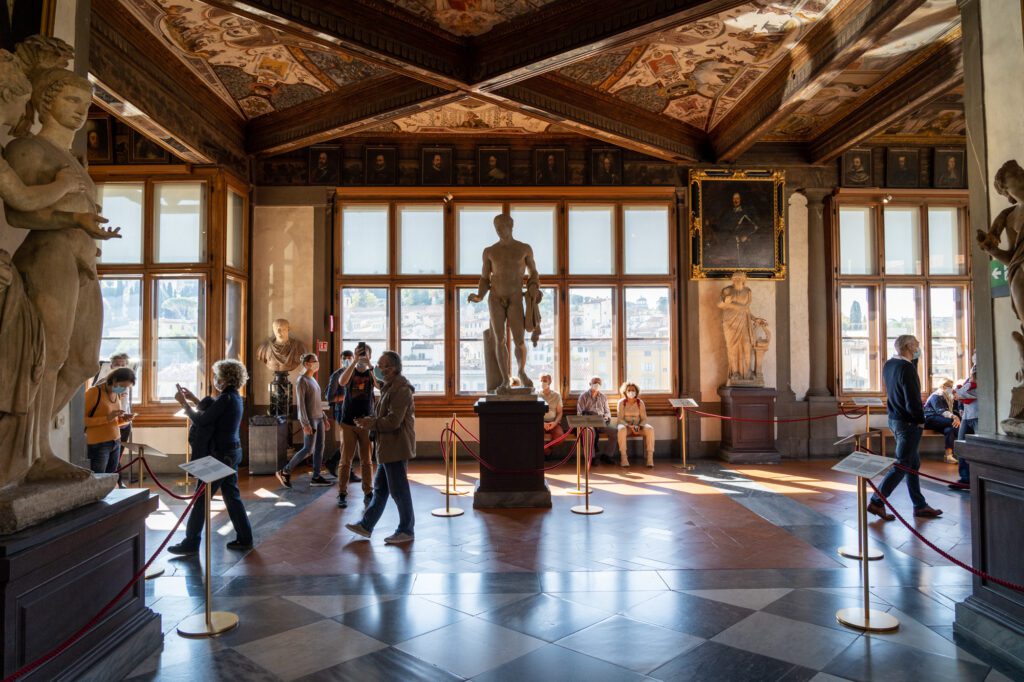
Of the two main museums in Florence, the Uffizi Gallery is BY FAR our top pick.
Yes, the David is a masterpiece, and the other works in the Galleria dell’Accademia that show you how Michelangelo’s relentless pursuit of understanding the human body led to the creation of the marble masterpiece. But we’ll talk about that in the next section.
What we really love are art museums that tell a coherent story, either about the place they’re located (the National Portrait Gallery in London), a specific movement (the Musée d’Orsay and Impressionism), or a specific artist (the Rodin Museum in Paris).
Similar to the Musée d’Orsay in Paris, which tells a compelling story about how the bad boys of Impressionism shirked conventional wisdom and forged their own path that later became one of the most iconic movements in art history, the Uffizi Gallery tells a story about the painters of the Renaissance that is inherently intertwined with the history of Florence.
A lot of people, us included, assume that Florence became a wealthy city because it had all of this beautiful art.
But the truth is actually the inversion of that statement – Florence was able to commission all of this gorgeous art because of its immense wealth, which was required to commission the famous artists of the Renaissance
The Uffizi Gallery is a chronological walk through time, starting with the period immediately before the Renaissance, where you had people mostly painting Jesus in two dimensions with a golden halo around his head, to the end of the Renaissance, when people were painting life-like figures in three dimensions that looked like real humans.
As you might imagine, we have been to the Uffizi Gallery multiple times, first on our own, then with the audio guide, then on (multiple) guided tours.
It wasn’t until the first guided tour we did (here is that tour) that we truly began to grasp what exactly we were seeing; a revolution in the art world that began and flourished in Florence.
We’d strongly recommend a guided tour here, and would rank it as the second historical/museum tour to do on this itinerary after the Colosseum because the story of the Renaissance really requires a bit of extra explanation and context.
Of the tours I’ve done, this tour was by far the best crash course, and it ends inside the museum so you can spend more time, if you’d like.
If you’re not going to do a guided tour, you’re going to want to book your tickets for the Uffizi Gallery well in advance, and plan the rest of your time in Florence around that timeslot.
This is the official website of the museum, and similar to the Vatican Museums, you’ll want to either book the first few timeslots of the day (what we’re doing on an upcoming trip to Florence) or a later afternoon timeslot, when the museum tends to be a little bit quieter.
You’re also going to want the audio guide, we think, if you’re not doing a tour. It’s a good middle ground between a tour and just wandering the museum on your own.
The David & the Galleria dell’Accademia
As we’ve already mentioned, the David is a masterpiece.
Cut out of a single piece of marble, it stands 17 feet tall (taller because it’s elevated on a pedestal the way it’s displayed) and towers above you in the Galleria dell’Accademia (where it is now housed).
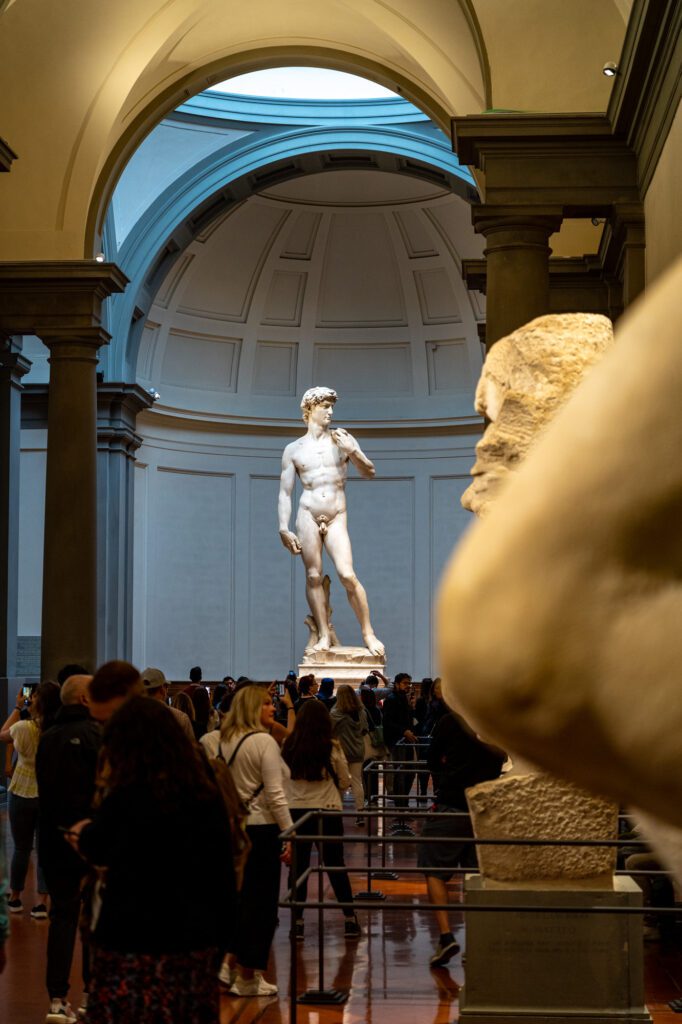
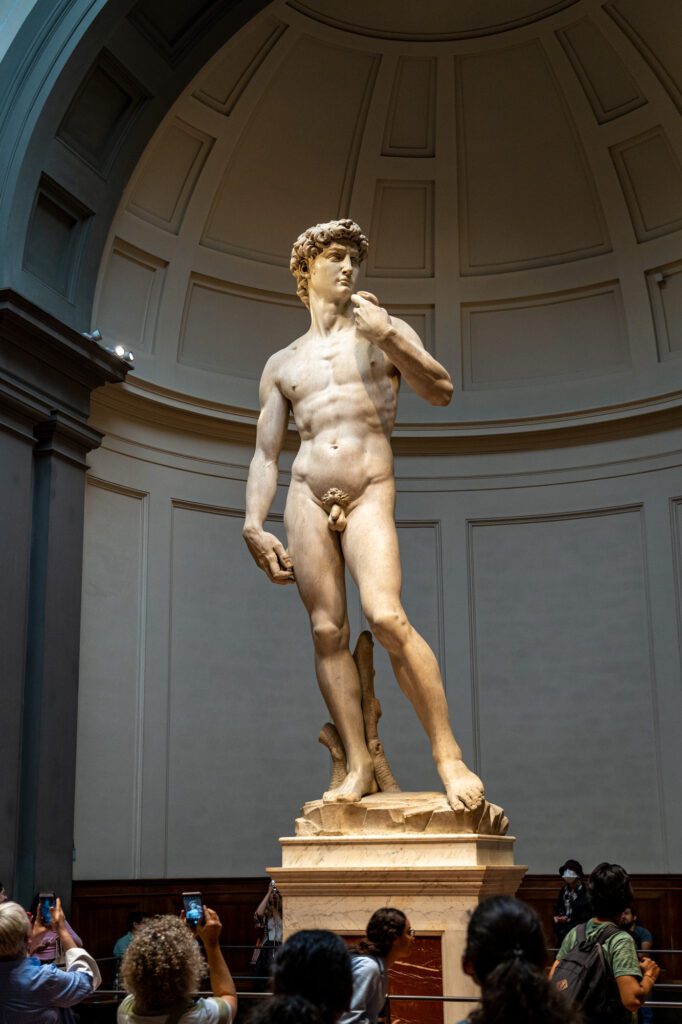
It used to be out on Piazza della Signoria, but was moved inside to protect it from the elements.
There is still a replica out on the piazza, along with another version up at Piazzale Michelangelo (which is a great view of Florence).
Many people come to this museum just to see the David, though we think it’s worth taking an extra second to stop and learn about Michelangelo’s process and how his brain worked, because I found it fascinating on my last visit.
If you’re interested in that progression and the artist’s fascination with the human body, it’s worth spending an hour or two in the Accademia (and seeing the statue in that context here, where you can walk all the way around it, is also cool).
However, if we had to choose one museum to do in Florence, we would not hesitate for an instant to point you to the Uffizi Gallery.
If you only have time or interest in one, do the Uffizi and go see the replica in Piazza della Signoria on your way in.
Book your tickets well in advance – we’re talking as soon as you know you’ll be in Florence – to avoid standing in the ticket office line (you will still have to stand in the security line), which you can do on the official website.
I’ve also done this guided tour of the gallery with my mom, which allows you to skip the long lines (and get tickets if they’re sold out through the official site) and offers a great overview of the story of Michelangelo and his career leading up to the David.
Take Andrea’s walking tour
We’re huge fans of walking tours as a way to get an introduction to a new city and connect with a local for tips on what (and where) to eat, drink, and shop.
And we loved Andrea’s walking tour, which is a two hour crash course in Florence’s rich history, with all the salacious details about the Medici family (they were essentially royalty in Florence during the 1500’s).
We loved it so much, in fact, that we actually have done that exact tour twice (most recently in 2025 with Matt’s mom and uncle).
He also has a more in-depth version of the tour that adds an hour and includes crossing the river to Oltrarno.
Climb to Piazzale Michelangelo
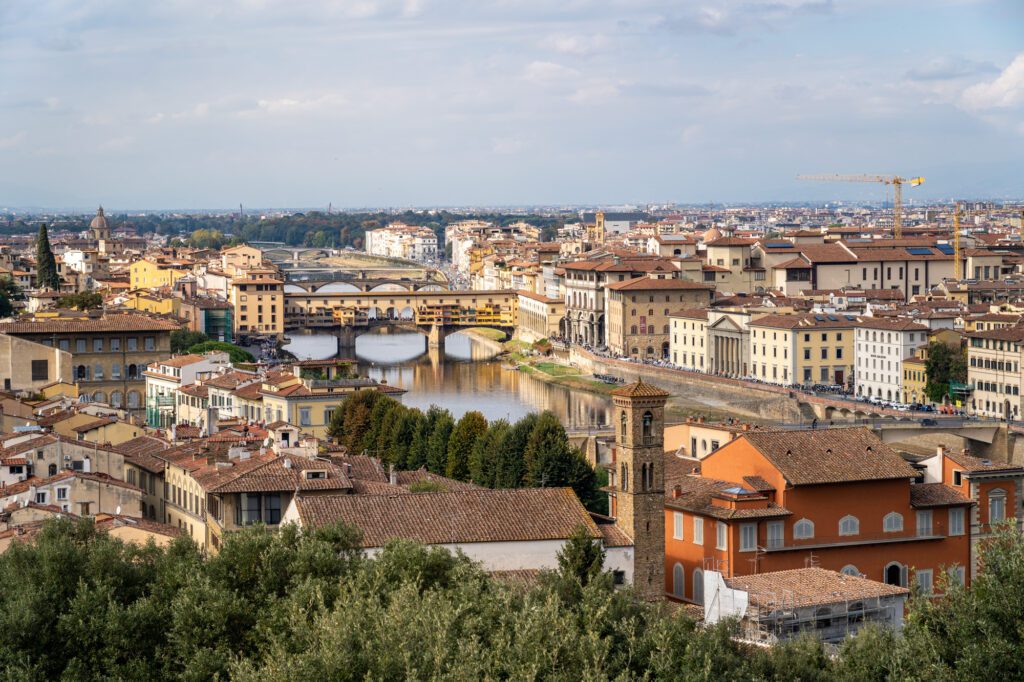
On the other side of the river from Florence’s Centro Storico, you’ll find what is arguably the best view of the city at Piazzale Michelangelo.
You’ll have a view of the Arno River and Ponte Vecchio (the only bridge in Florence that wasn’t destroyed in World War 2), the Duomo, and the rest of the city.
It’s nice at sunset, but it’s busy. Early in the morning is even better, because the sun is behind you and there are basically no crowds.
Climb Brunneleschi’s Dome
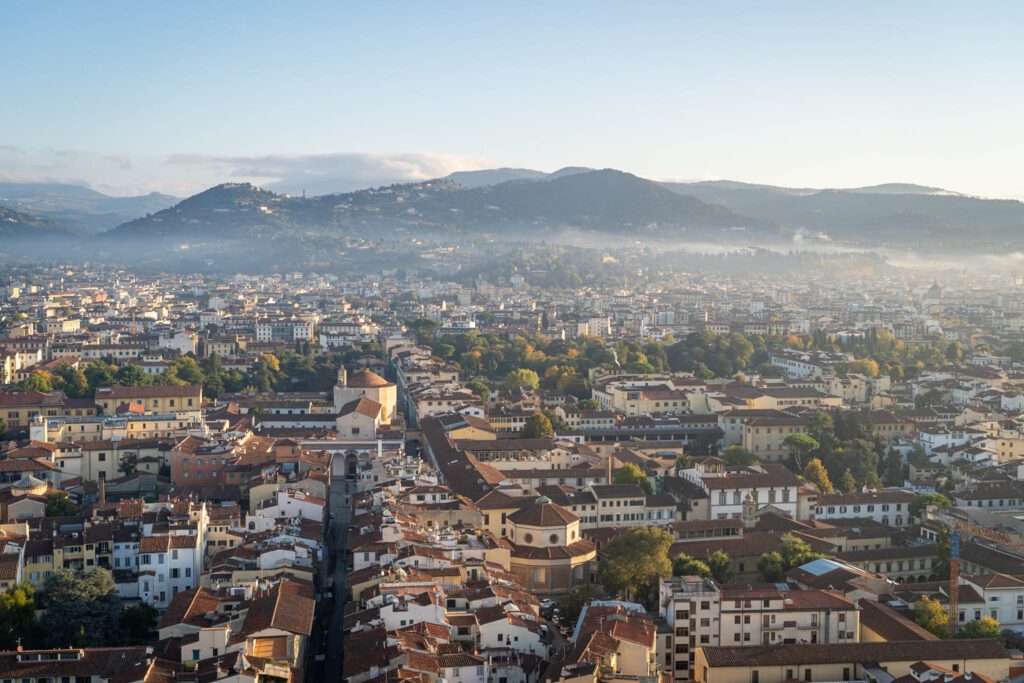
The Duomo in Florence is massive. The best way to experience it, in our opinion, is to climb to the top.
Along the way, you’ll get a view of the interior of the dome and the (somewhat creepy) artwork decorating it, then you’ll climb through the area between the interior and exterior dome (which gives you perspective on how it was built 600 years ago, which is mind-boggling) up to the top, where you’ll have a 360-degree view out over Florence.
Try to do it first thing in the morning for the fewest people, and book in advance here.
Dive into Tuscany’s food and drink offerings
We’d strongly encourage you to skip the pizza in Florence, and instead indulge in some of the local specialties.
We love Pappardelle al ragu di cinghiale (a pasta with a wild boar sauce that my mom fell in love with), pappa al pomodoro (tomato and bread soup), and the Schiacciata (sort of like a focaccia sandwich, but slightly different).
We liked the food at Trattoria da Garibardi.
Most of the Florentine cuisine pairs well with the Tuscan reds like Chianti Classico and Brunello, which are a couple of the more prestigious red wines to look for.
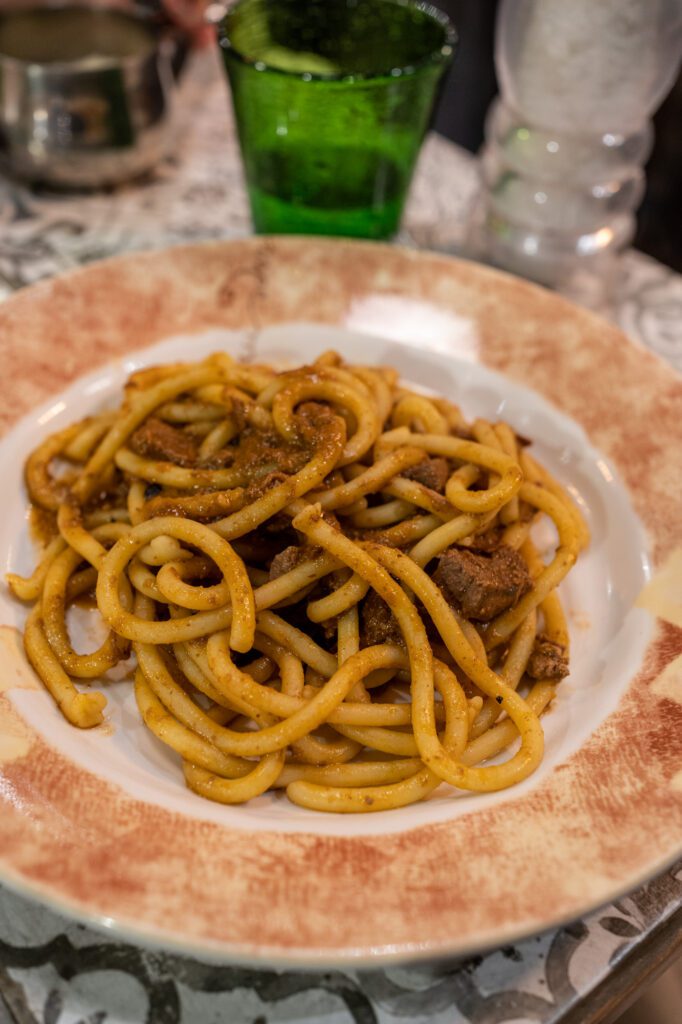
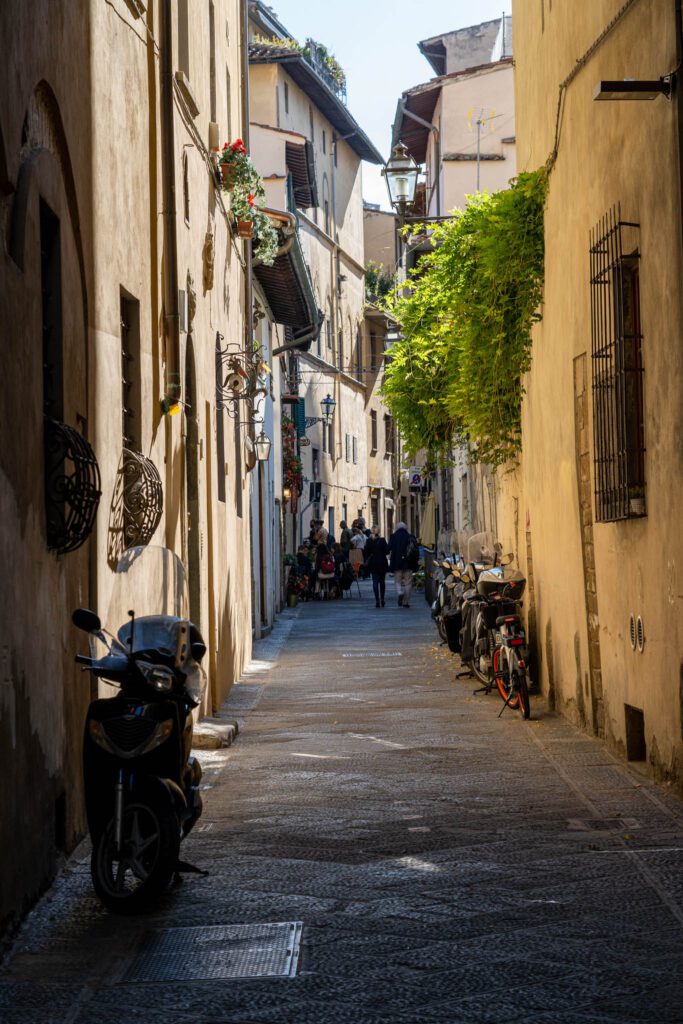
Where to Stay in Florence
Similar to Rome above, we have two recommendations for where to stay in Florence.
Also similar to Rome, your choice is going to be between the coolest neighborhood (in our opinions, anyway) and the most convenient area.
Convenience matters a little more here because you will be taking a day trip, which means you’ll be going to and from the train station.
Our favorite area in Florence is Santa Croce / Sant’Ambrogio, which is a five minute walk east of the Duomo. It has the best food (we think), fewer tourists, and is close to everything in the city.
We stayed at Pietrapiana Boutique Apartments for almost a week, and it was everything we wanted and more: access to a kitchen, a little more space to spread out, a quiet refuge from the hustle and bustle, and a comfortable place to sleep. Highly recommend!
La Maison du Sage is another good option nearby – it’s more of a traditional hotel than serviced apartments.
The other option, which is best if you want to be super central to everything in Florence, is Florence’s Centro Storico, which is centered around the Piazza del Duomo and nearby Piazza della Signoria (home to the Uffizi Gallery).
It’s crowded, it’s loud, but it’s super convenient. It’s also closer to the train station for your day trip.
Day 7: Choose Your Own Day Trip from Florence
Florence is the capital of Tuscany, which might be Italy’s most famous region for its wine and general dolce vita feeling. And, after spending a week in Tuscany, we can definitively say it delivers on both.
Florence is an excellent base to explore Tuscany from, with most of the highlights accessible within 90 minutes by train.
However, the main issue with Tuscany is that you really need a car to be able to see certain things properly.
Here are the three day trips from Florence we’d recommend, and which one you choose totally depends on what you’re interested in.
If you’re looking to combine San Gimignano, Chianti, and Siena into one day, it’s going to be a long day, but this tour with Walks of Italy (which, as we’ve already mentioned a few times in this guide, is one of our favorite tour companies on earth), covers San Gimignano, Chianti, and Siena in one action-packed 10 hour day.
Day Trip 1: Siena for the Cathedral (and the History)
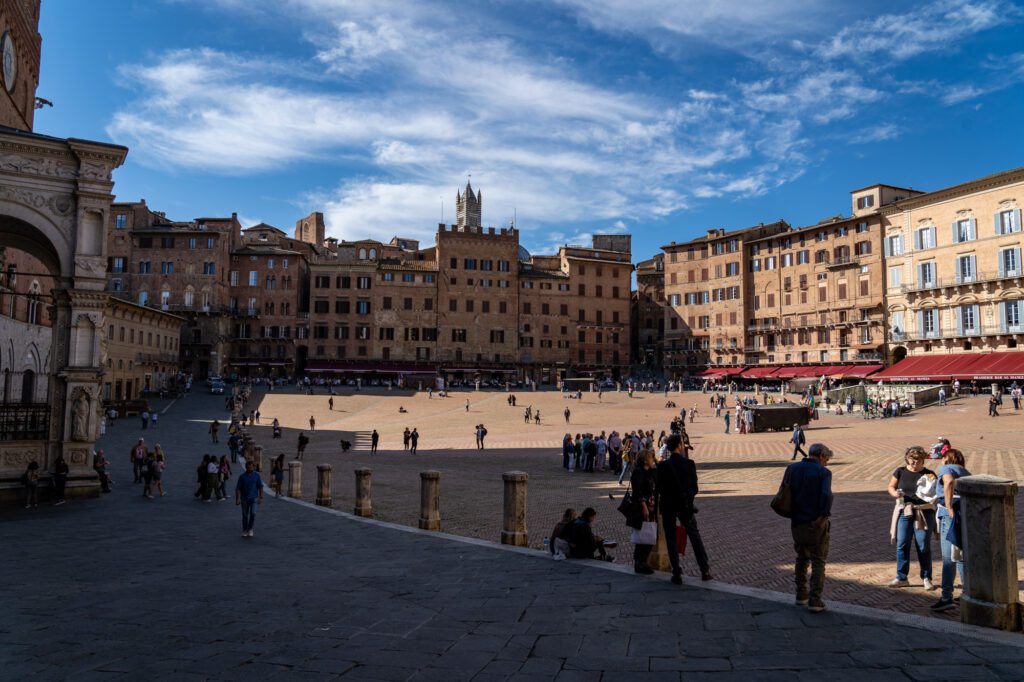
Siena is a popular day trip from Florence, and it’s a 90 minute train ride south in the heart of Tuscany.
There is, perhaps, no better example of a classic hilltop town than Siena, which is a red city perched on a hill overlooking a lush green valley.
The cathedral in Siena is incredible, and we say that as people who usually don’t get all that excited about massive opulent churches.
The iconic dark green and white stripes of Siena’s Duomo are just the beginning of what makes it special.

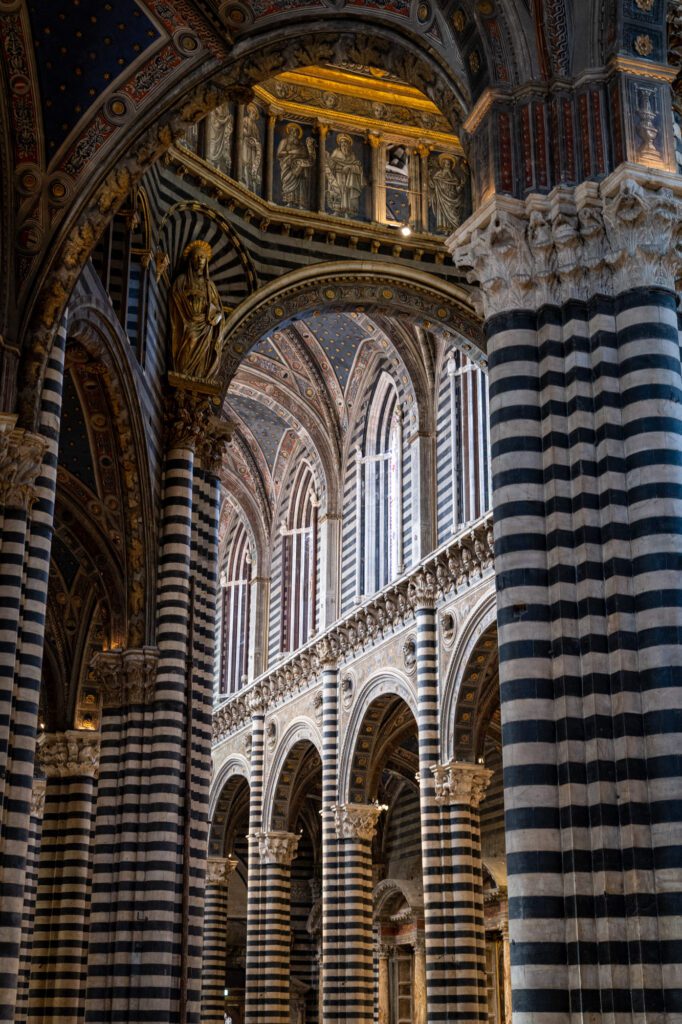
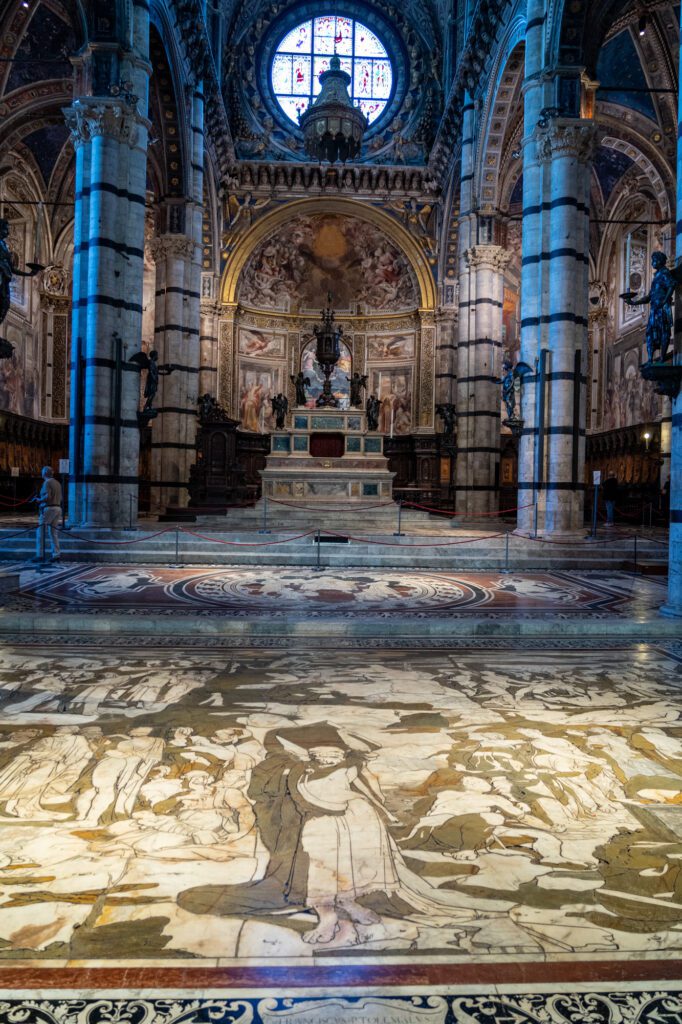
The interior is where the real fun begins, particularly if you’re around when the floors are uncovered (usually in the summer), and the intricate art and tilework on the floors is on full display.
We recommend climbing up to the Facciatone, which is a viewpoint inside the Museo del Duomo that has an excellent view of both the cathedral and the surrounding landscape.
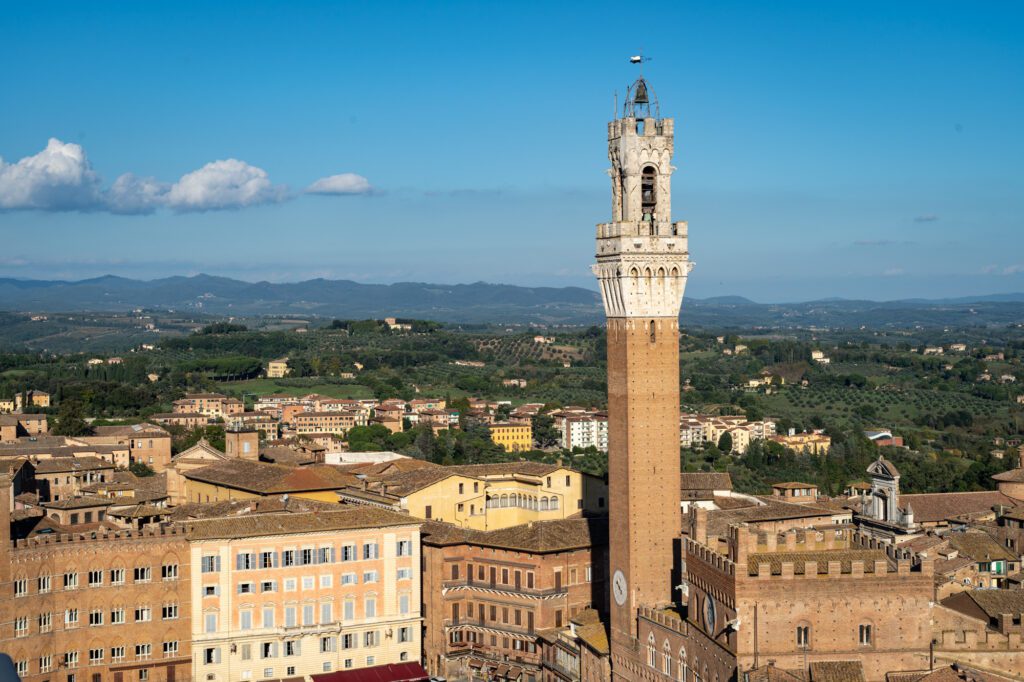
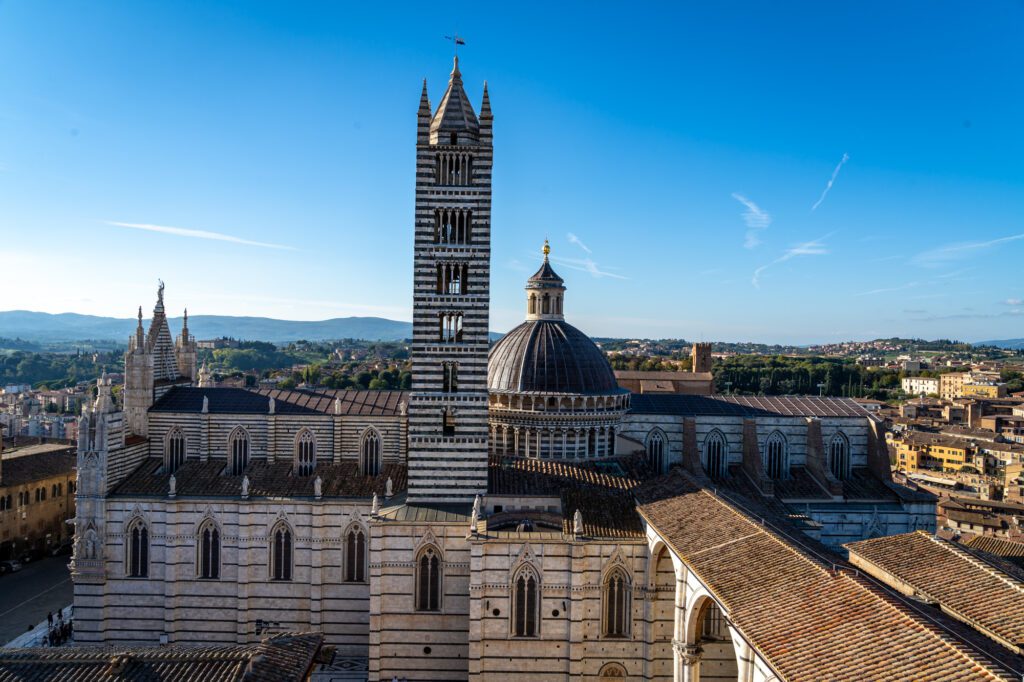
The other place not to miss in Siena is Piazza del Campo, which rivals Piazza Maggiore in Bologna (more on that in a second) as our favorite piazza in all of Italy.
In terms of eating and drinking, head to Torrefazione Fiorella for a morning coffee at a stand-up bar (very Italian), Panificio Il Magnifico to try sweet Sienese specialties like ricciarelli, Du’ Cose Da Berna for traditional sandwiches at lunch (a recommendation from our friendly host at the agroturismo we stayed at outside of Siena), and Ristorante Gallo Nero, which was one of the best meals we had in Tuscany.
How to get there: There are regional trains between Florence’s Santa Maria Novella (the main station in Florence) and Siena that take about an hour and a half. You can also take bus 131 (or the faster 131R) from the Florence bus station (here on Google Maps – it’s right next to Santa Maria Novella), which is a similar amount of time. Both are very affordable options.
Day Trip 2: Chianti for the Wine
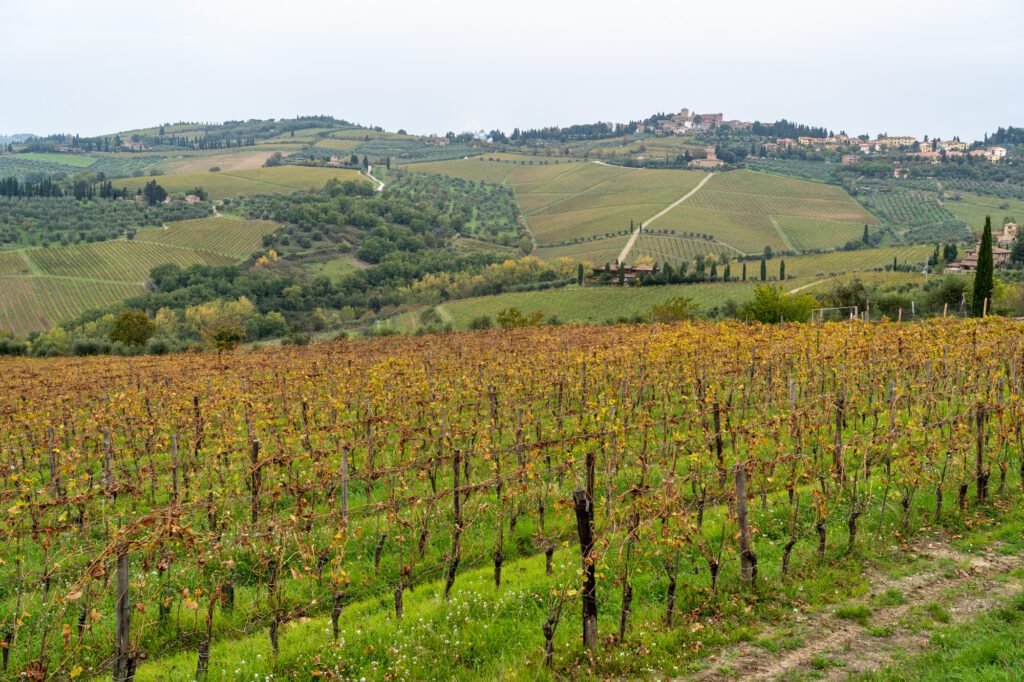
Chianti is the place to go for wine. Chianti classico is the name of the game here, which is a Sangiovese-based red wine that follows strict production methods, and is one of the most famous wines that comes out of Italy.
If you don’t like red wine, I have some bad news for you – Tuscany is all about the red wines (except for vernaccia, which is a white wine that comes from San Gimignano!).
Assuming you don’t have a car, your only option here is to do an organized tour because doing a self-guided tour of Chianti wineries would require both a rental car and a designated driver.
In terms of guided tours, you have two options.
You can either choose a tour that goes deep on a single winery, usually including a cellar tour and detailed tasting (but you’ll have to make your way out to the winery), or a tour that takes you around to multiple wineries, which is going to be a little less personal, but give you more breadth where you’ll get to see multiple approaches AND usually includes transportation to and from Florence.
We did this tour of a tiny organic winery and olive farm at the northern end of Chianti, and we loved it.
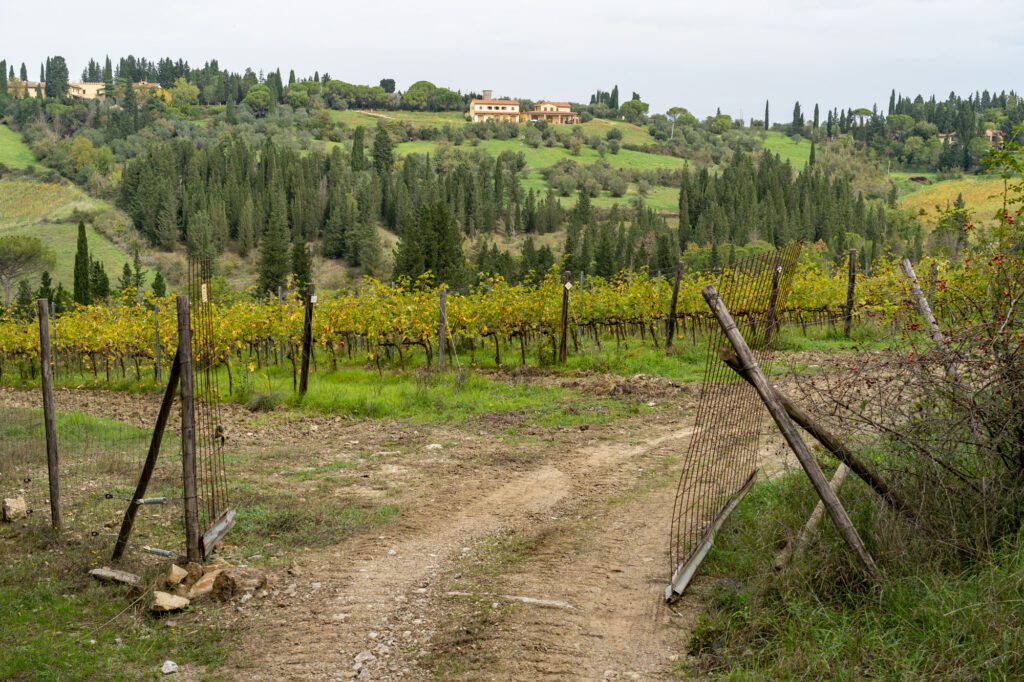
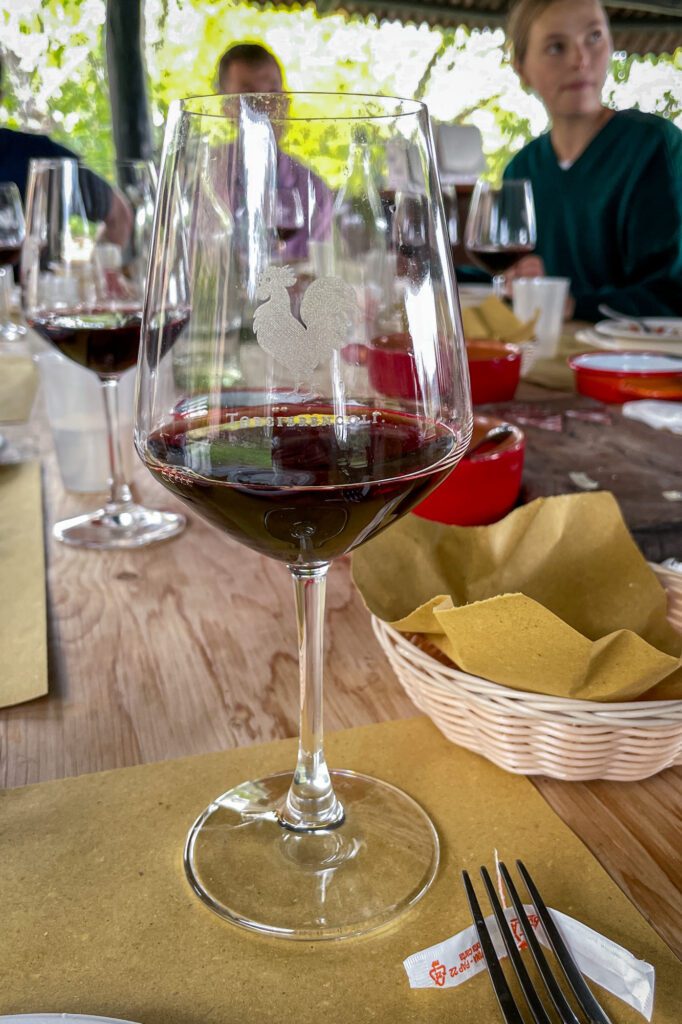
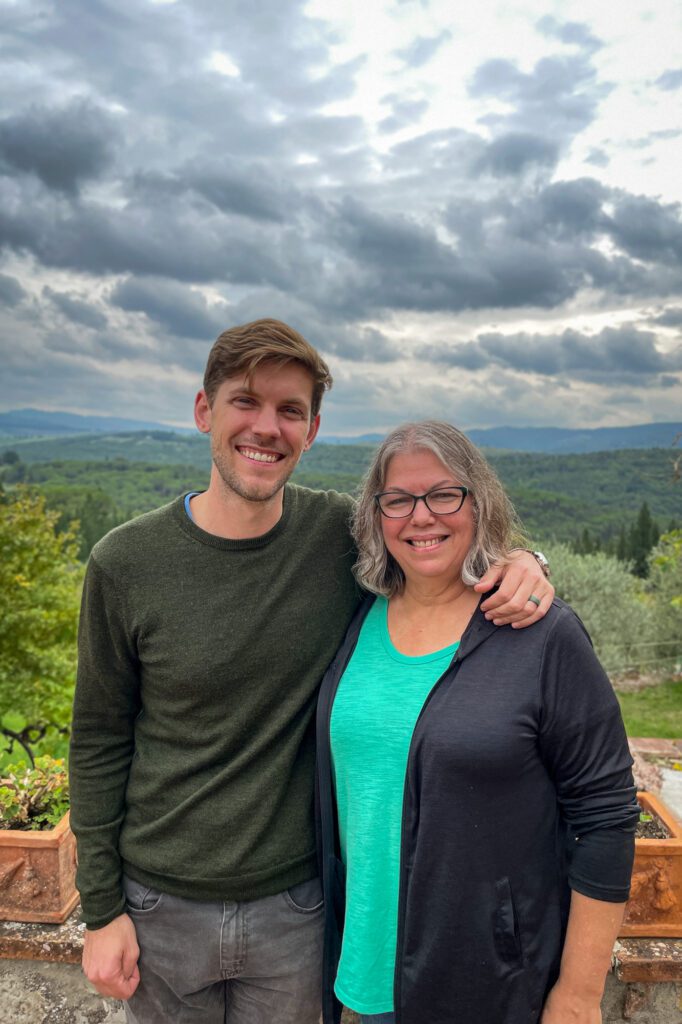
It was very personal and intimate, and we learned a ton about growing grapes (and olives) in Chianti.
We’d highly recommend it, and the nice part is that it’s easily accessible from Florence (and the hosts will help you figure out how to get there, including a bus station pickup).
In terms of the other option where you get to visit multiple wineries with transportation to and from Florence, this is a highly rated tour with a sommelier that we considered.
You’ll get to visit three wineries, which are all closed for public visits, which is a good sign that it’s a unique experience because the host clearly has relationships with those specific wineries.
If you want to see more of Chianti, including the super charming Badia a Passignano, we’d go with this tour.
Day Trip 3: Lucca For the Views
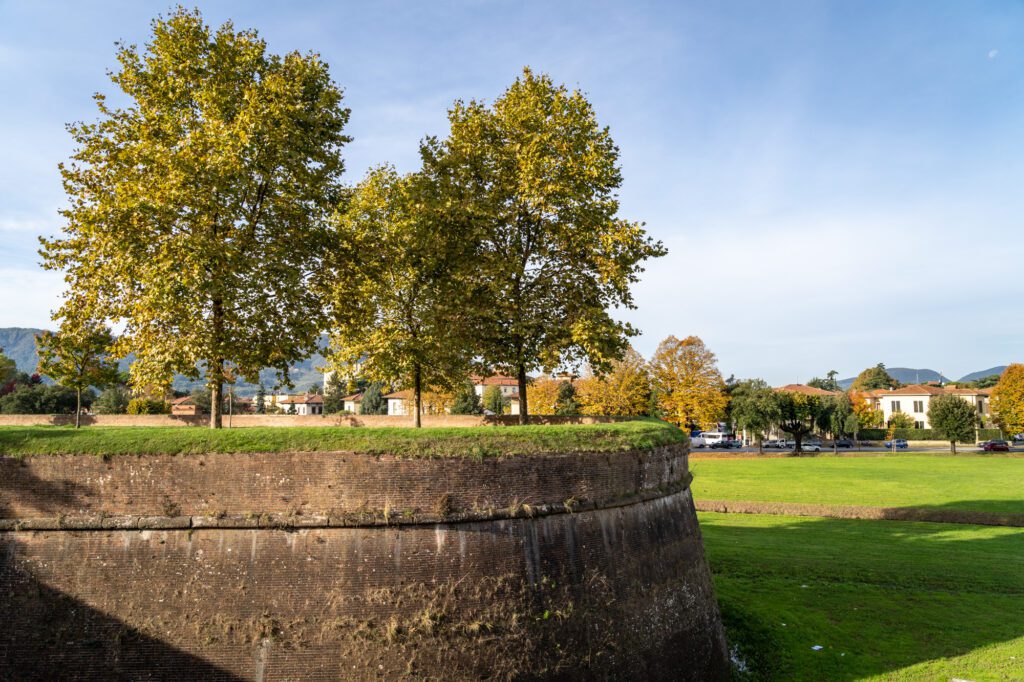
You might have been expecting to see Pisa somewhere on this list of day trips from Florence, and we’re here to tell you that while, yes, the leaning tower is kind of cool, we would absolutely recommend skipping Pisa (which is crowded beyond belief with people wanting to see the aforementioned leaning tower) and heading to Lucca instead.
There are a couple of reasons we love Lucca.
First, the medieval walls are still intact, encircling the entire city. It’s well worth walking the full loop, where you’ll get some nice views of the city and the mountains beyond.
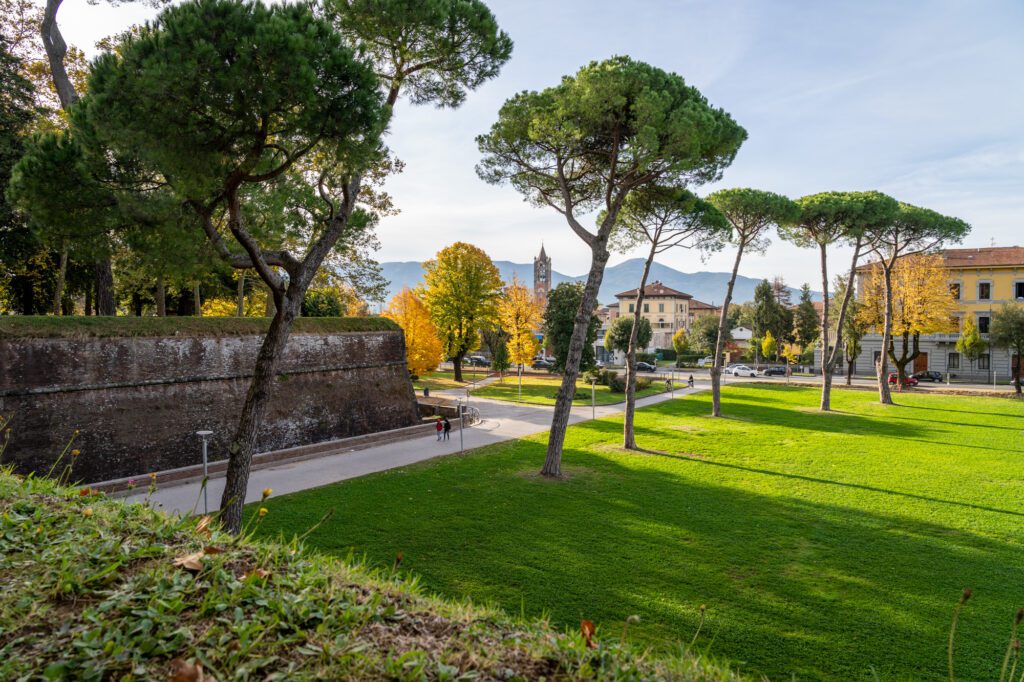
Second is the tower. Climbing the Guinigi Tower will take you up to what might just be our favorite view in all of Italy.
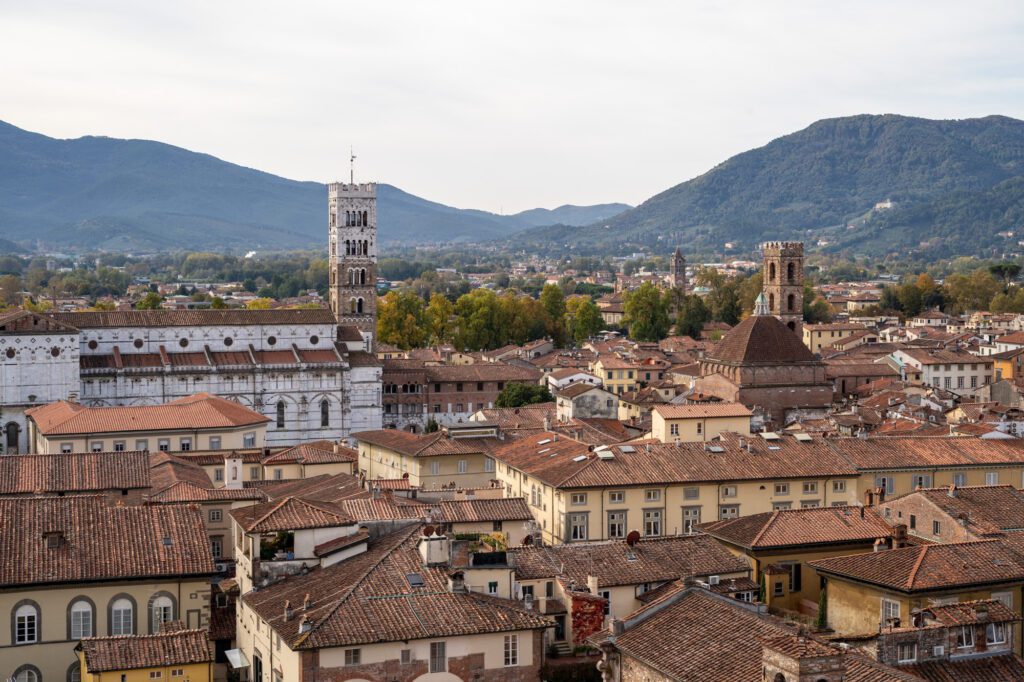
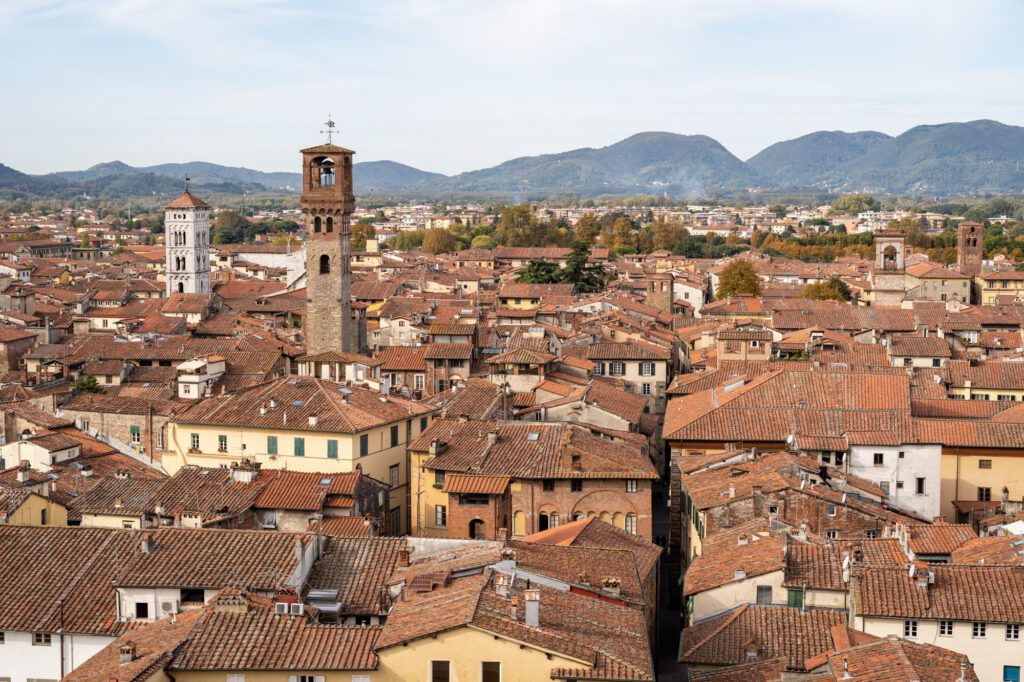
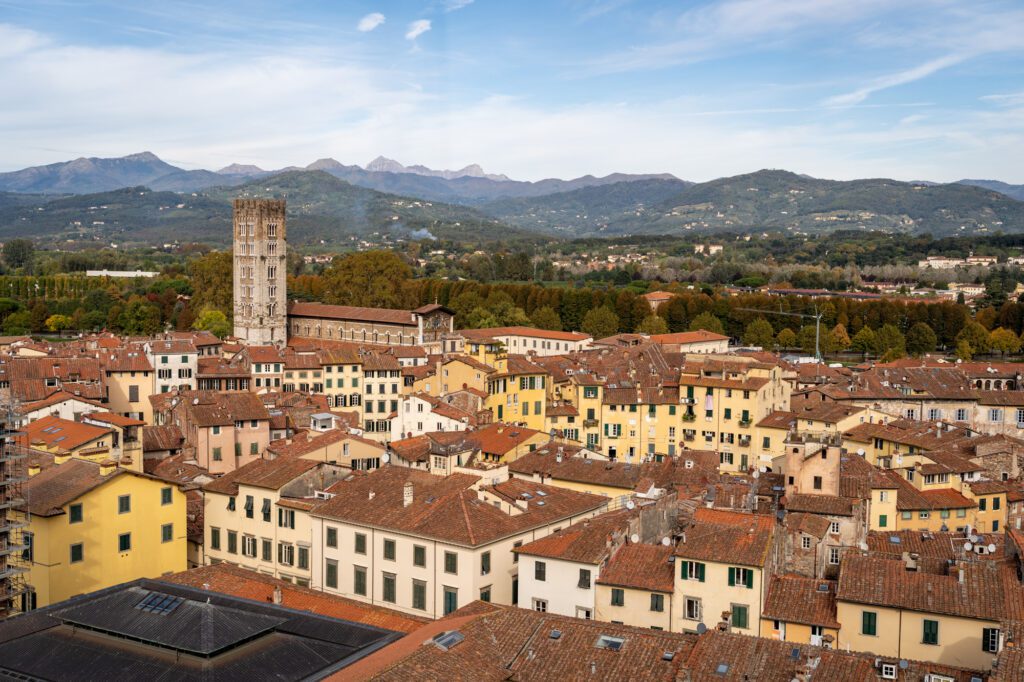
On a day trip to Lucca, we’d spend your time walking the city walls, climbing the tower, and indulging in some Luccan cuisine for lunch (at Trattoria L’ Angolo Tondo, which is right on the Piazza dell’Anfiteatro where a Roman amphitheater used to be), which is slightly different than the food you’ll find in Florence because of its proximity to the coast, which means more fresh seafood.
How to get there: There are regional trains between Florence’s Santa Maria Novella (the main station in Florence) and Lucca that take about an hour and a half. They come frequently, and they’re super affordable.
Days 8 & 9: Bologna
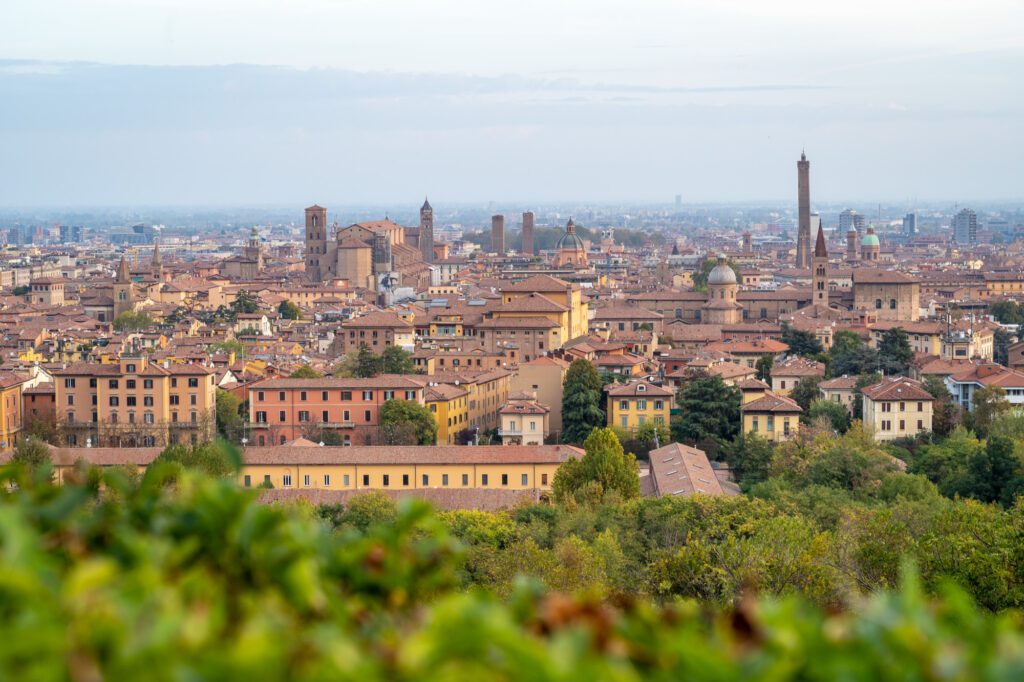
You’re probably a little bit surprised to see Bologna on this itinerary, since it’s not exactly known as one of the “must-see” cities in Italy. However, we’re here to tell you that it absolutely should be on your list, particularly if you love food.
One of the most interesting parts about traveling to Italy is having our expectations about “Italian” food completely shattered.
Here in the US, Italian food (we now know that Italian–American food is an entirely separate thing) consists of heavy sauces with lots of garlic, garlic bread, and chicken parmigiana.
The truth is that Italian food culture is vastly different from region to region, and depends a lot on the fresh ingredients available in close proximity.
For example, in Sicily, you’ll find tons of fresh seafood because you’re on an island and are perpetually near the coast.
In Tuscany, it’s olives, wild boar, and sheep cheese (pecorino) because those are the ingredients that are readily available.
If you made us choose our favorite Italian food region, we’d choose Emilia-Romagna, which is where you’ll find Bologna.
Here’s an exercise: write down your five favorite Italian ingredients (rather than dishes). If you’re anything like us, at least one of the things you wrote down comes from Bologna’s region, Emilia-Romagna.
There’s a reason the city is known as “La Grassa” (“the fat one”). It’s about as close to heaven for foodies as you can get.
There are, of course, other things we really like about Bologna. It’s a city of towers that overlook the distinctive red brick buildings (most of them are facades, though).
It’s a University town (one of its other nicknames is “La Dotta” which means “the learned one”) and it has a distinctly younger vibe than just about any other major city in Italy. There are far fewer tourists than any other city you’ll visit.
And it’s well connected to just about every corner of Italy.
We think you should spend three nights in Bologna, using one of those nights to do a day trip up to Verona, which is another one of our favorite cities in Italy.
What to Do in Bologna
Here are a few of our favorite things to do in Bologna. For more, head over to our guide to spending a day in Bologna.
Climb the Asinelli Tower for Excellent Views
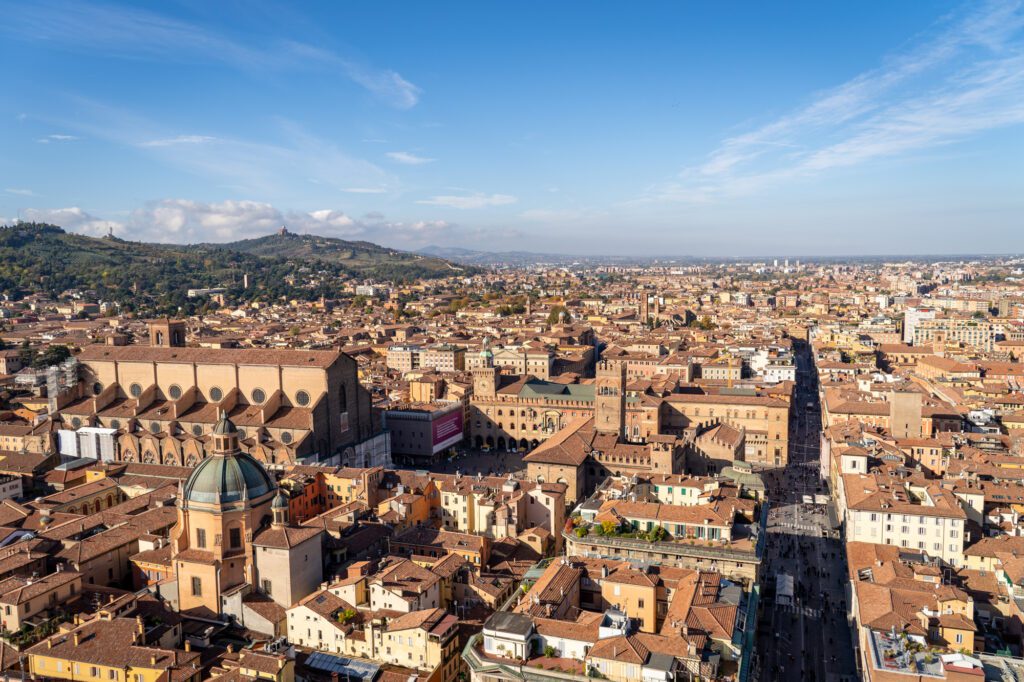
We have friends that live in Bologna, and when we visited them on our first ever visit to Bologna, this was the first thing they did with us.
It’s a big climb, but you’ll eventually end up on the top of the taller of the Due Torre (“the two towers”), where you’ll have a commanding view out over Bologna.
Book here in advance for a timeslot.
Eat your heart out
Mortadella and filled pastas like tortelloni come from Bologna, but the broader region is home to just about every delicious food we associate with Italy.
Parmesan, balsamic vinegar, prosciutto di Parma, lambrusco, and ragu alla bolognese.
Go to any of the places in Quadrilatero, which is right off of Piazza Maggiore, to taste and shop.
Specifically, we like Tamburini for tagliere (a plate of meats and cheeses) and a glass of wine (lambrusco!), Cremeria la Vecchia Stalla for excellent ice cream (which is NOT the same as gelato), and Vineria Favalli for their excellent Italian wine list.
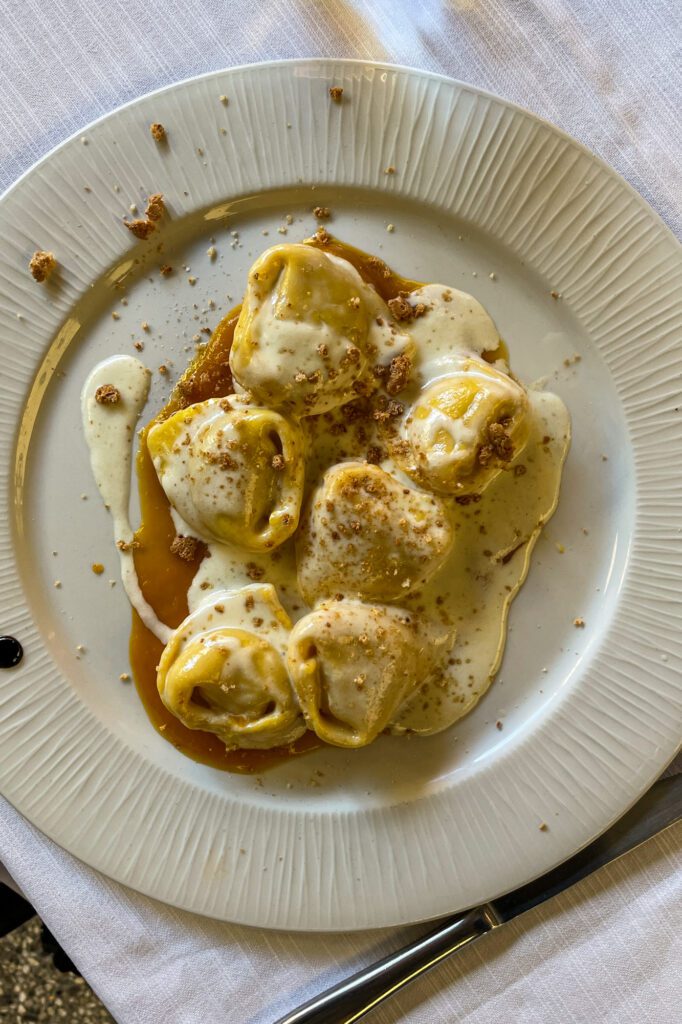
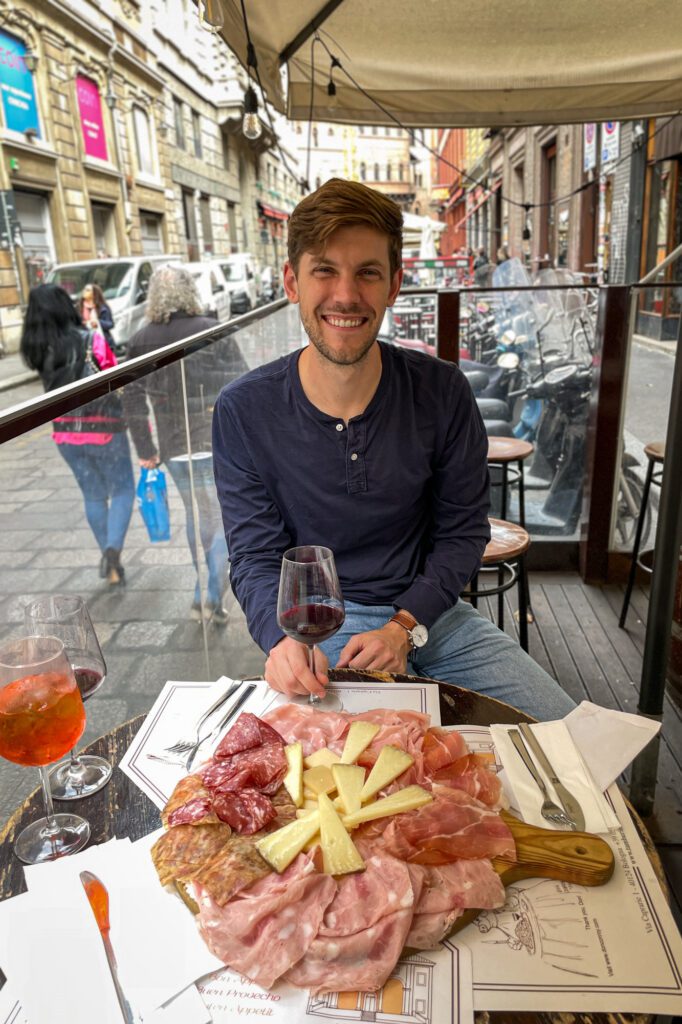
Take a food tour with a local guide
While you can absolutely get a sense for Bologna’s food offerings on your own, a food tour is going to be the best way to dive a little deeper.
This food tour in Bologna was on our list, but after learning they couldn’t accommodate gluten free diets (which, by the way, makes total sense), we decided to skip it.
Take in Piazza Maggiore and Basilica di San Petronio
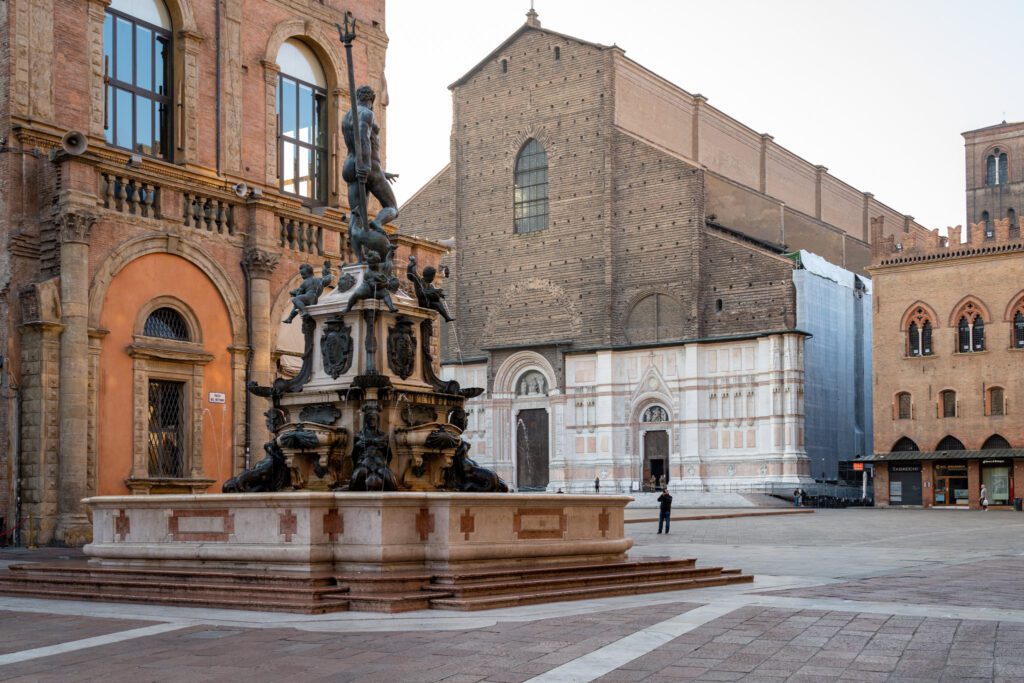
Piazza Maggiure is the beating heart of Bologna, and one of Italy’s best piazzas in our opinion (as we noted above, Siena’s Piazza del Campo is a close second).
There are events nearly every afternoon and evening, from rallies to concerts, and even when there isn’t an official event, you’ll find some of Bologna’s best musicians out on the square (along with a crowd of admirers).
The church is worth going into, but it’s only half finished after they tried to make it outshine the Vatican, who said “you can’t do that.”
That’s why part of the church’s facade is exposed brick, which is the unfinished portion, while the other part is covered in marble.
Make the climb to Santuario Madonna di San Luca
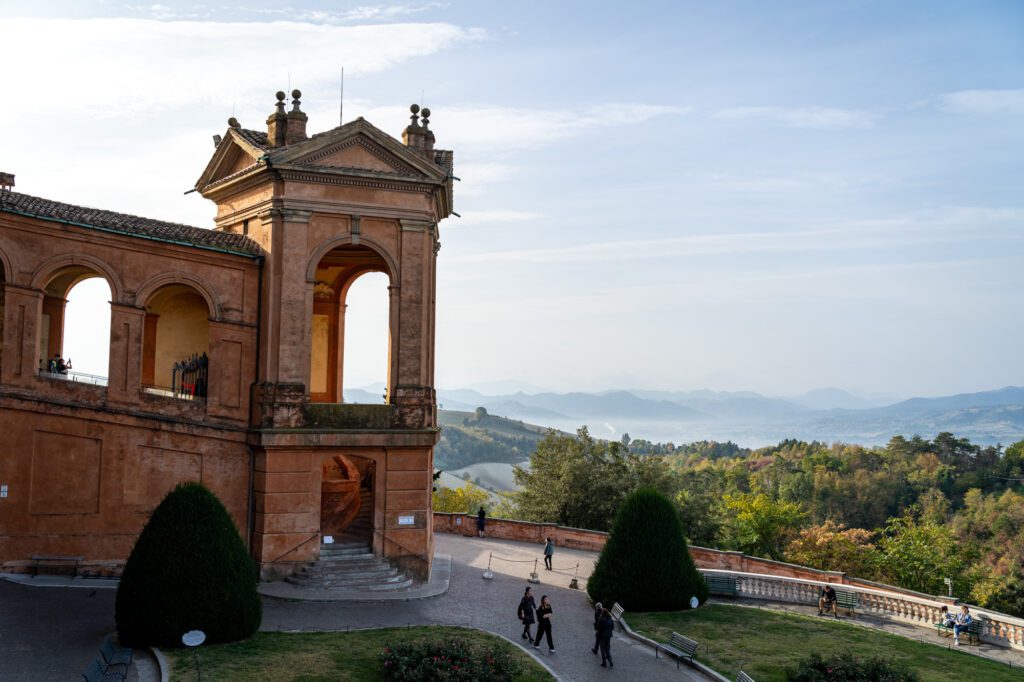
Bologna is known for porticoes, which are essentially just covered walkways, and you can walk through the 666 (someone has a sense of humor) to get up to this church on the hill.
For what it’s worth, this the #1 recommendation from our friends that live in Bologna.
Where to Stay in Bologna
There’s no doubt in our minds – you should stay near Piazza Maggiore while you’re in Bologna. It’s the beating heart of the city, and it’s going to be both the most convenient and the coolest place to stay.
I spent a few days in Bologna solo on my last trip to Italy, and stayed at Bibliò Rooms and Guesthouse. It’s essentially a small B&B that takes up one floor on a residential building about five minutes from Piazza Maggiore.
The rooms are fairly spacious with comfortable beds and private bathrooms, and it’s a good home base for a few nights in Bologna.
I also stayed at the Social Hub in Bologna, which is a hip, young-feeling hotel in Bolognina up near Bologna Centrale.
While the location is further away from Bologna’s main attractions, it is a gorgeous hotel with all sorts of great amenities (a pool, a nice gym, a bar, an events calendar, and ping pong, to name a few). Plus, it’s about five minutes on foot from the train station, so it’s convenient in that sense.
If you’re looking for an apartment, look at Canonica Suites, which is where I kind of wish we had stayed.
We have an entire guide dedicated to helping you figure out where to stay in Bologna with FAR more detail, if you want more of an in-depth look at your options.
Day 10: A Day Trip to Verona
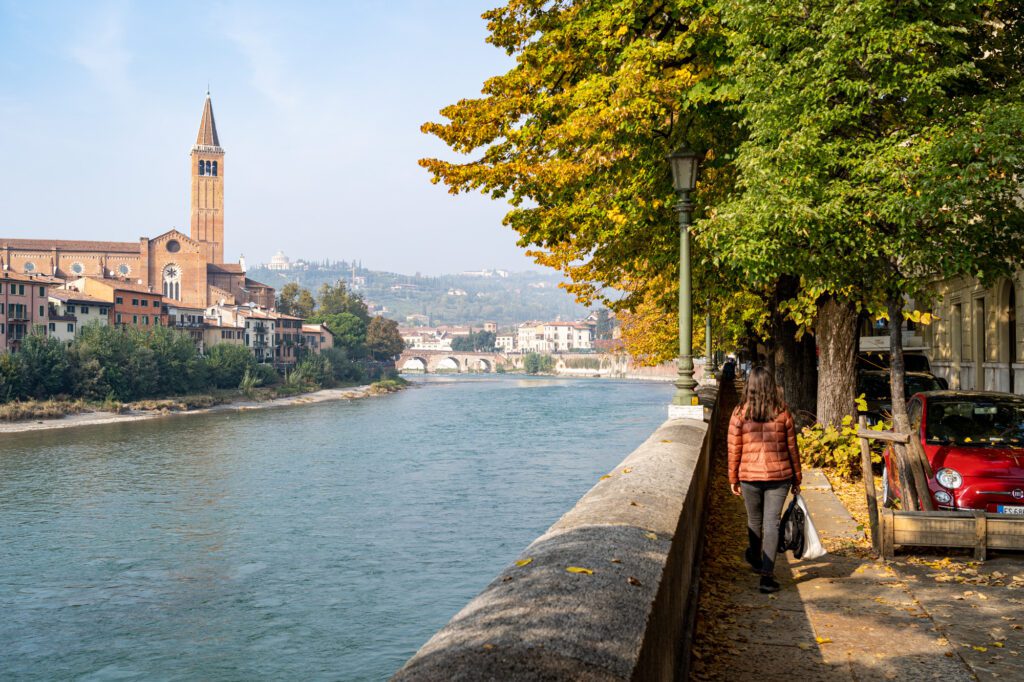
On this day, we’d highly recommend leaving your stuff in Bologna and doing a day trip up to Verona, heading back to spend the night in Bologna.
Verona is famous for being the setting for Romeo and Juliet, but it tied with Bologna for our favorite discovery in Italy when we spent six weeks exploring Italy a few years ago.
You might be wondering why we’d do it this way, considering Verona is sort of on the way to Venice (the next stop in this itinerary).
The reason is that we don’t want you to have to worry about juggling your bags, and instead focus on getting an early train from Bologna without the worry of check in times and baggage storage.
Take the high speed train, which takes about 45 minutes or so (book in advance for cheaper tickets!).
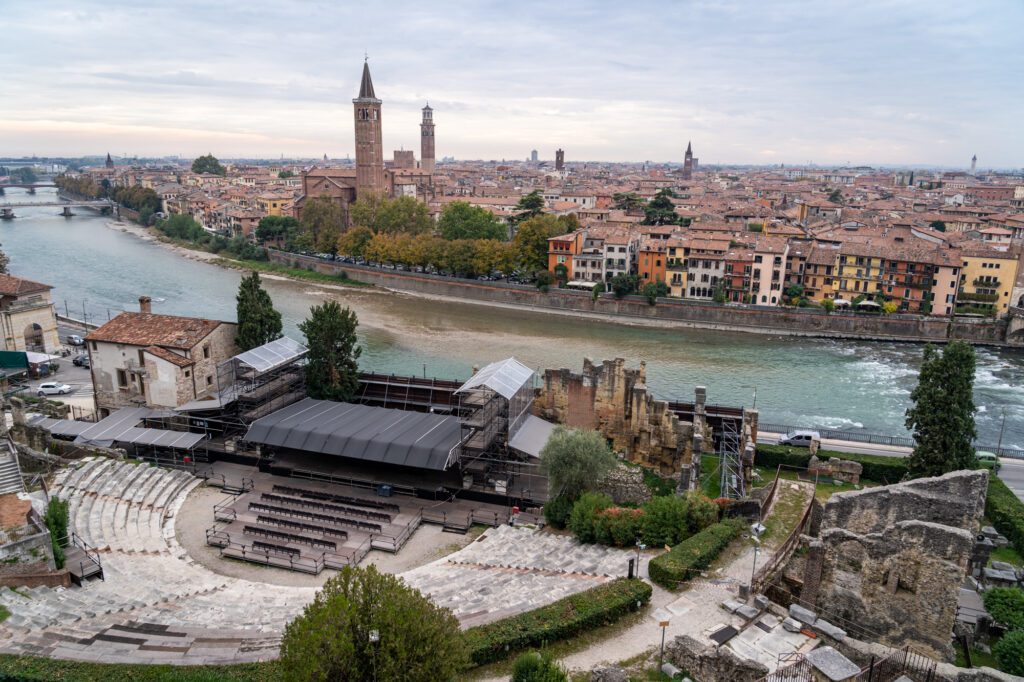
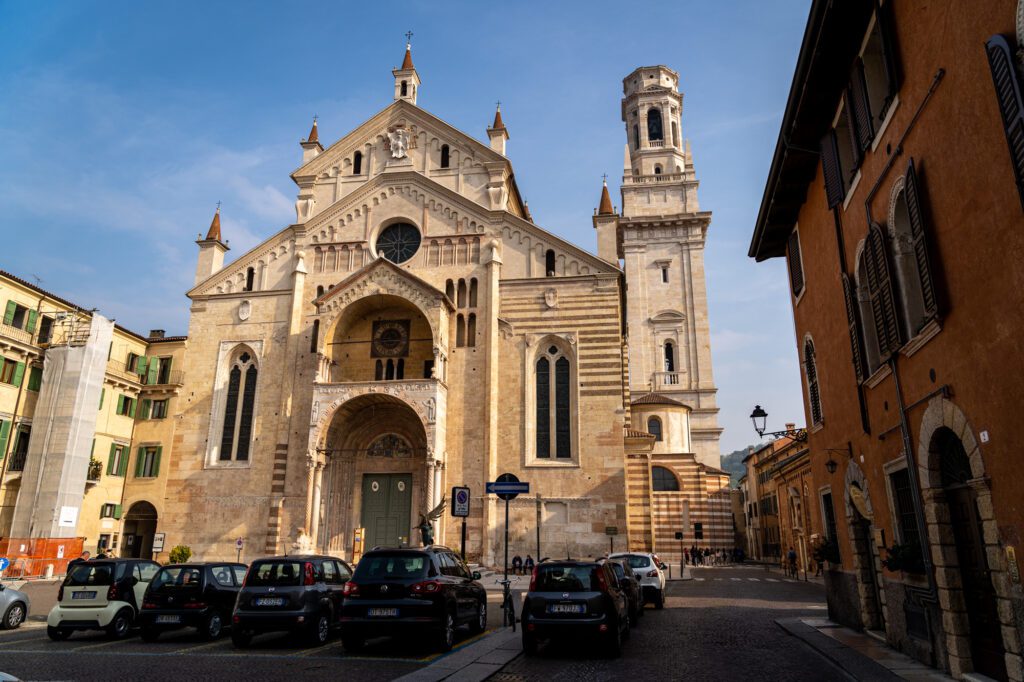
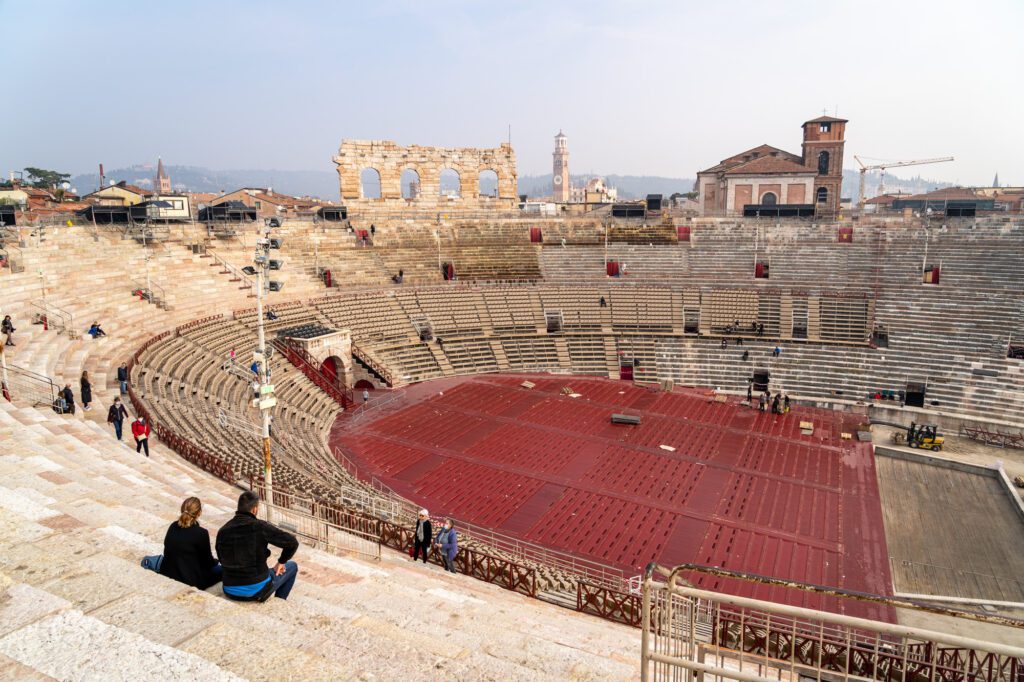
Rather than go into the details of what to do and see with a day trip up to Verona, we’re going to direct you to a separate blog post where we go through exactly that.
Here’s how we’d spend a day in Verona.
Days 11-14: Venice
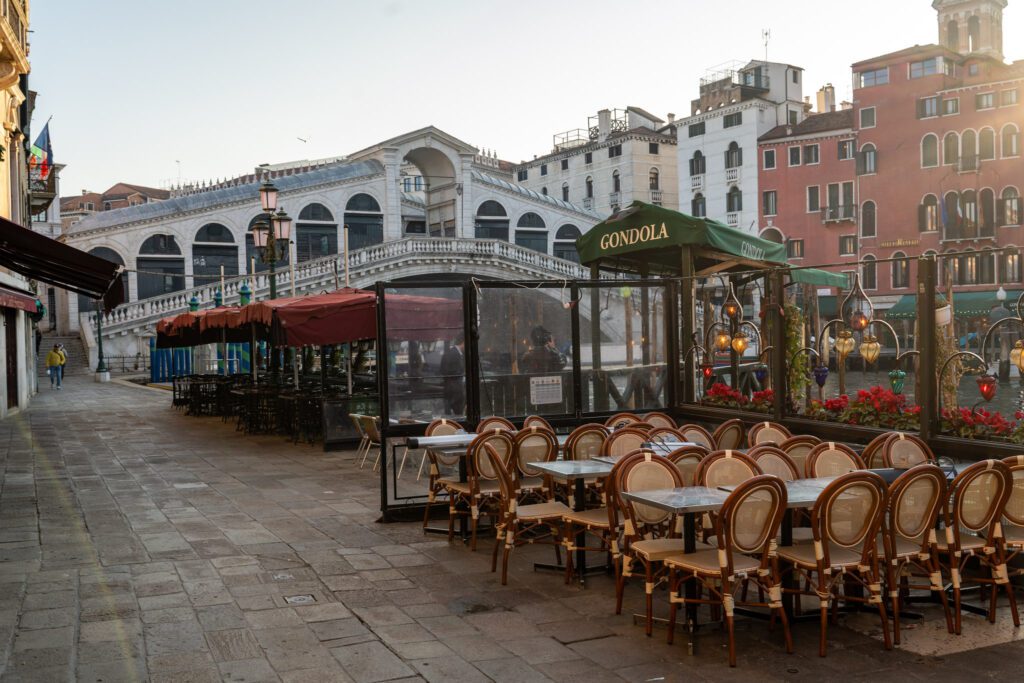
We go back and forth on Venice and whether it’s worth visiting, and how much time to spend there.
Venice is a place that inspires strong opinions on both ends of the spectrum, and to some extent there’s truth in both sides of the “argument.”
Yes, Venice is hot, crowded, and inauthentic (in places), especially if you’re there during peak season in the middle of the day.
Yes, Venice is beautiful, enchanting, and one of the most unique places to visit in Italy because of its geography (there’s a reason it has been on the tour-de-Europe for centuries).
Before my trip to Venice this spring, I was pretty sure I would never set foot in Venice again.
Mostly because my previous trip (a decade earlier) had brought me to Venice in the middle of August, when it was unbearably hot and crowded, we stayed outside of Venice (more on that choice in the where to stay section below), and we basically spent the entire time near Piazza San Marco (which is now my least favorite part of the city).
As you might imagine, I was very much in the hot / crowded / inauthentic camp at that point.
But after visiting again in the early spring and spending almost all of my time outside of the corridor between Rialto Bridge and Piazza San Marco, I’m now firmly in the second camp, with the caveat that when you visit and how you spend your time very much matters, and will shape how you perceive Venice.
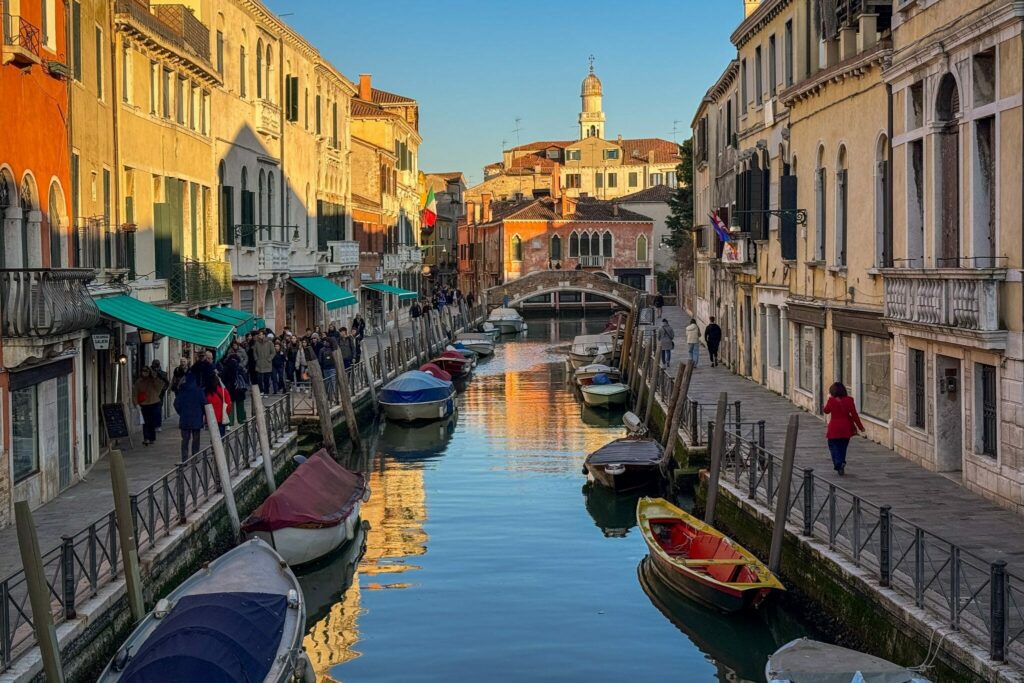
Of all of the places you visit on this two week itinerary, we think Venice is the most unique. There aren’t many cities that were built right in the middle of a lagoon, and the way that choice has shaped the physical city and its culture to this day are really interesting.
We always say (and we’ve already said it in this guide multiple times) that the regional diversity that exists within Italy is what makes it special to us, and Venice is an excellent example of that idea.
It’s a completely different city and culture than you’ll find in Rome, Florence, or Milan despite the fact that they were all united under the same country.
What to Do in Venice
Here are some things that we think you definitely shouldn’t miss while you’re in Venice. For more (both more things to do and more detail behind the things below), head over to our guide to the best things to do in Venice.
We also have a guide to spending three days in Venice which, conveniently, lines up with the amount of time we have dedicated to the city in this itinerary.
St. Mark’s Basilica (Basilica di San Marco)
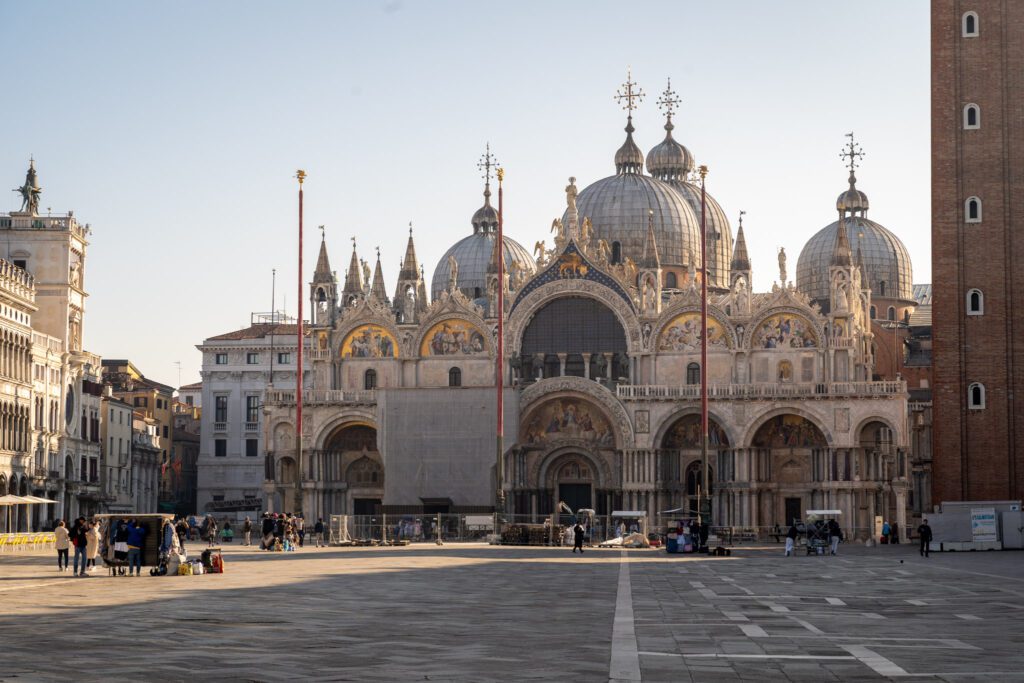
This church is magnificent. On my latest trip to Italy, I got to see St. Peter’s Basilica in Rome, the Duomo di Firenze, and St. Mark’s Basilica in Venice.
This basilica was my favorite of the three, though that might be influenced by the fact that I had seen the other two more recently, and it had been nearly a decade since I had set eyes on the golden mosaics covering every inch of the ceiling of the church.
We don’t have time for it here – read our Venice itinerary for more historical context on the basilica – but I love the origin story of the basilica, specifically how they got the relic (St. Mark’s body) to make it official.
I did this after hours guided tour of the Doge’s Palace and Basilica di San Marco, and it was a completely different experience than I’ve ever had visiting those places on my previous two trips.
We were literally one of two or three groups inside each place, which is a far cry from the hundreds (maybe thousands?) of people who are inside at peak times.
It’s also worth noting that I never would have been able to understand what exactly I was looking at without our guide, Romi, who explained the history and design and architectural elements in exhaustive detail (not to be confused with exhausting detail).
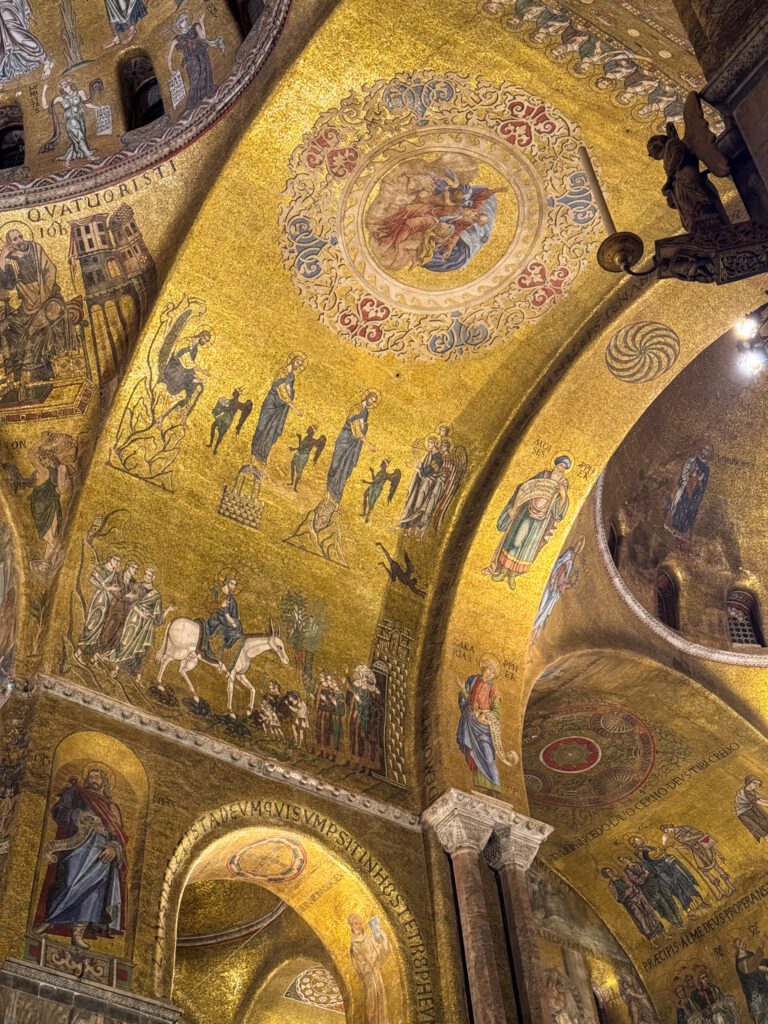
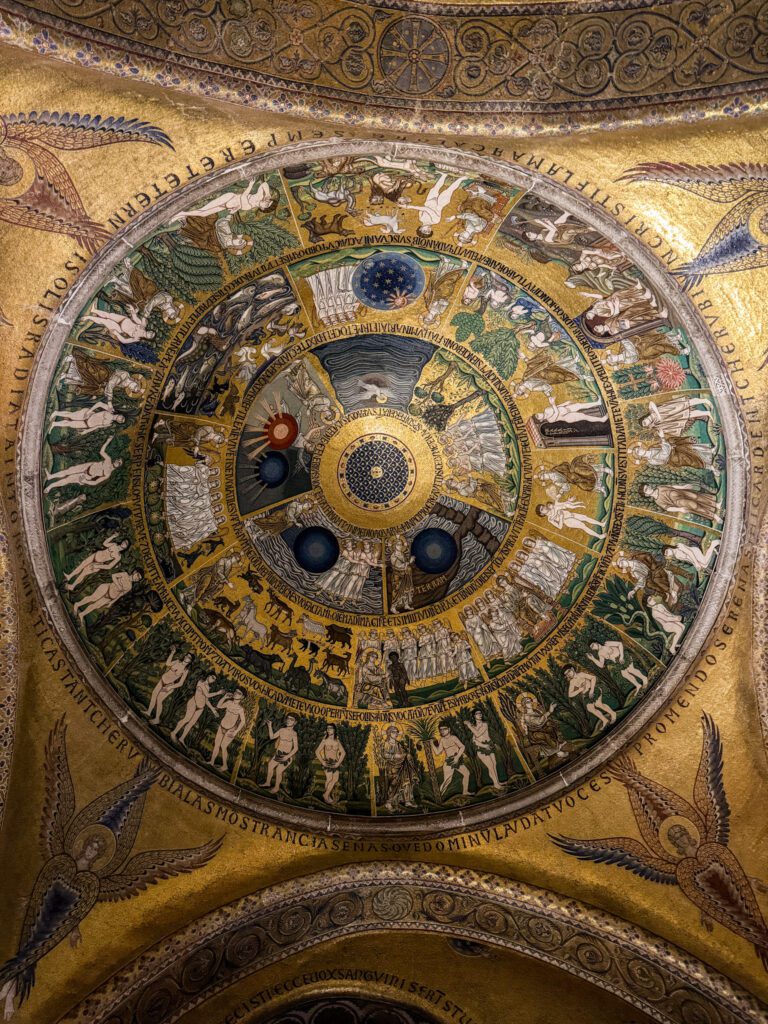
They also have a separate after hours tour specifically for the basilica, which splits the tour I did in half (and skips the Doge’s Palace).
If you’re going to visit on your own, it’s worth paying the extra cost (and sacrificing flexibility) to book in advance on the official website and skip the ticket office line, which can take a bit of time during the peak season.
The Doge’s Palace
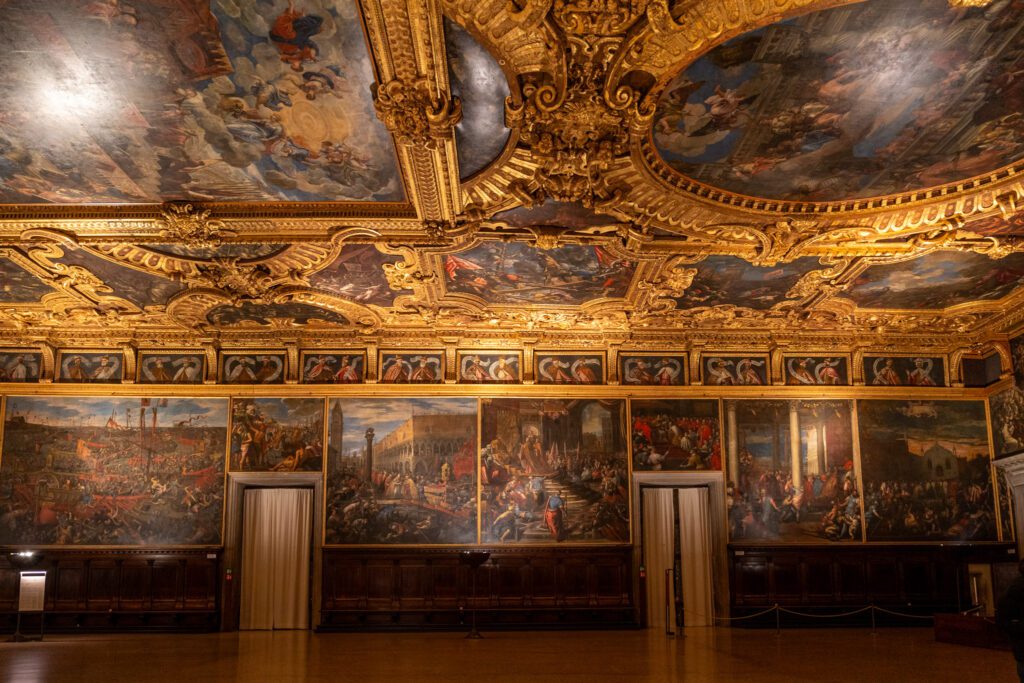
Piazza San Marco, where you find both the Basilica di San Marco and the Doge’s Palace next door to each other, was both the political and religious (funny how they go hand in hand) center of the Republic of Venice.
The Doge, roughly equivalent to the duke or mayor in English, lived and worked here, and it’s equal parts residence, offices, and prison.
The basilica is cool because of the art and architectural elements, and while the Doge’s Palace has its fair share of that too with its beautiful painted ceilings and ornate golden trim, it’s more interesting from a political perspective.
The interior is incredibly ornate, especially in the Grand Council chambers, with dark wood, plenty of gold, and the trademark colorful frescoes that you’ll find all over Venice (the Venetian painters LOVE their bright colors and textured fabrics) painted by legends like Tintoretto and Titian.
This is, as the saying goes, the room where it happened.
If you’re American, it’s like the White House (the Doge’s apartments were here) and Congress put together – with a little bit of Alcatraz thrown in for good measure.
If you have limited time, money, energy, or interest, and you have to choose between the Basilica and Palace, I’d choose the basilica every time because of the intricate mosaics (think about the work of installing all of them!).
If you want to visit the Doge’s Palace on your own, you’re definitely going to want to buy tickets in advance. Especially because the ticket price is €5 cheaper if you book more than a month in advance (€25 if you buy more than 30 days in advance, €30 if you buy within 30 days).
The official website for the Palazzo Ducale is here, and you can buy tickets directly through them.
The other thing to know is that the public opening hours on Friday and Saturday are extended to 11pm between May 1st and the end of September (basically, peak season) and it is generally much less crowded in the evening hours.
If you’re looking for a way to see the palace without all the crowds you’ll encounter during the day, that’s a good option.
See Venice from the Water
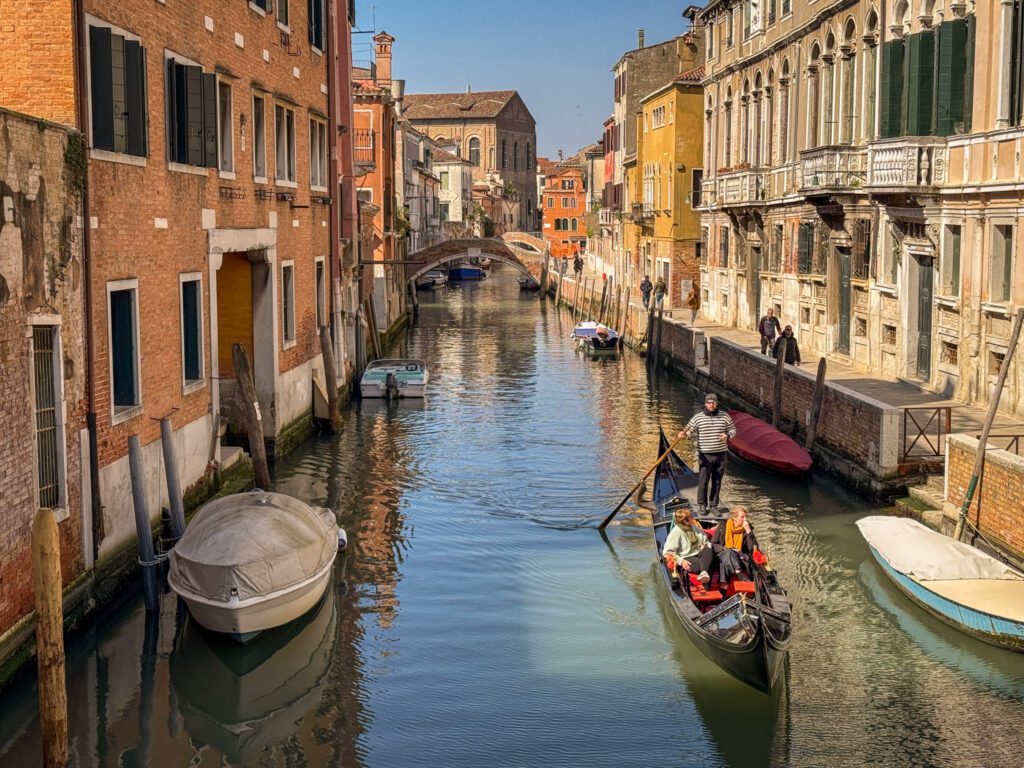
After an excellent canal cruise in Amsterdam, another European city that is built on the power of water with its numerous canals, I think that seeing the city from the water is an essential piece of any itinerary for Venice because it offers a completely different perspective.
However, I’m hesitant to recommend hopping on one of the innumerable tourist gondolas that you’ll find all over the city, with their “drivers” in striped shirts and berets because I don’t think it offers a whole lot of insight into the city AND your experience is going to vary wildly based on the gondolier you get and where you pick up the boat.
Generally speaking, we think there are three options to get out on the water and see Venice from a different perspective.
First, the public waterbus (the vaporetto), which is relatively affordable and accessible, but does only really stick to the bigger canals (which means you miss the magic of the smaller, less-trafficked canals in Venice).
Second, the stereotypical gondolas that you see all over the city. We’re not going to get into whether or not this is worth it, because that’s a personal choice, but it is a unique experience.
The price of a gondola ride is regulated throughout the city and, at the time of writing, a daytime gondola ride (9am to around 7pm) is set at €90 for a 30 minute ride, while an evening gondola ride is priced at €110 (for a 35 minute ride). Don’t pay more than that for those durations and times of day!
Also, that price is per boat (usually a max of five people per boat), not per person, and this is going to be what you might call a “private” gondola, meaning you and your companions are the only ones in the boat (with the gondolier, of course).
Last is to join a guided tour of the lagoon by shared boat.
If you don’t care so much that the boat is specifically a gondola, a shared boat ride is likely going to be a better overall experience – a better value (you might pay slightly more per person, but get ~3x the time on the water), better storytelling (to learn about Venice’s history and culture), and better comradery with other travelers interested in the same things as you.
Personally, this would be my choice between the two organized options (the other being the private gondola), but that should check out if you’ve spent any time at all in this corner of the internet.
Explore Venice’s Less-Visited Neighborhoods
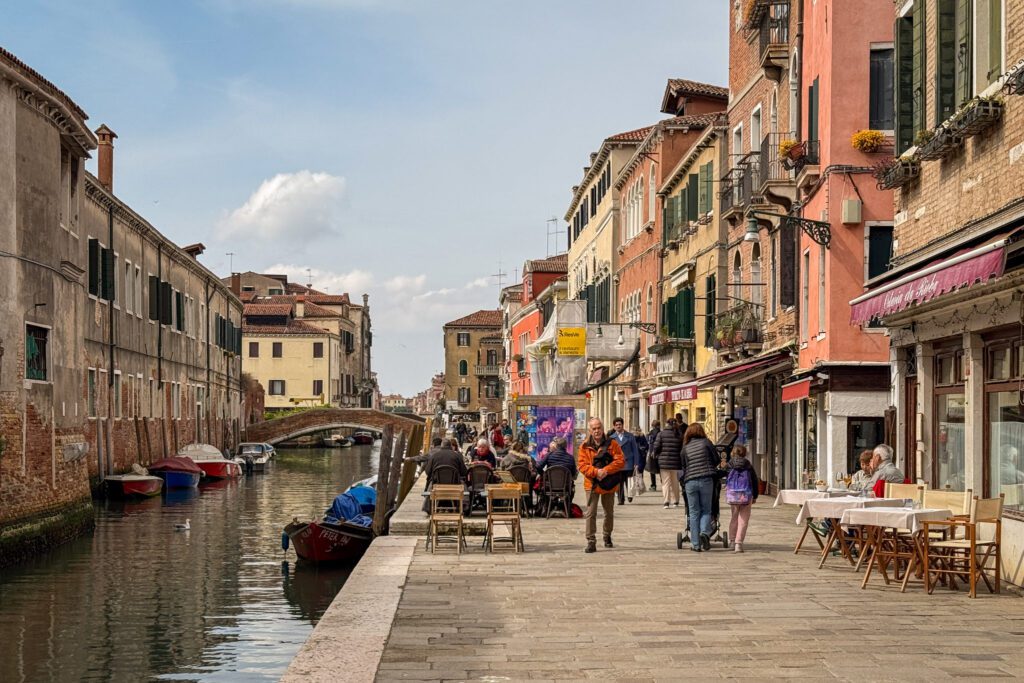
90% of tourists spend all of their time in the corridor that leads from the train station to Rialto Bridge to Piazza San Marco, never straying from that well-worn path.
Knowing that, it’s really no wonder that people view Venice as crowded and inauthentic!
I had multiple experiences throughout my few days in Venice on this most recent trip where I found myself in Venice’s other neighborhoods walking several blocks, crossing canals, and not seeing another soul.
All it took was wandering a few blocks off of the main street in the area to find that peace and quiet.
Venice is broken up into six sestieri (which can be roughly translated to “districts”), and the vast majority of people spend their time exclusively in San Marco.
Of the six, there are three that I found myself drawn to, and they form a spine down the center of the city. They are Cannaregio (the northern end of the city), San Polo (the eye of the storm in the center of the city), and Dorsoduro (the southern end of the city).
We’d make sure to spend some time in each of those places, because even at peak times in Venice, they’re relatively quiet compared to the stretch between Rialto Bridge and Piazza San Marco, and they’re packed with great places to eat, drink, and wander.
Experience the Wonders of Cicchetti + Spritz
Of all of the food options in Venice, which are heavily influenced by the lagoon and the bounty of fresh seafood, the most unique aspect of Venice’s food culture is the cichetti.
These are mostly consumed in the afternoon (between lunch and dinner) and come in several forms, kind of like tapas and pintxos in Spain.
Sometimes, it’s a bite-sized portion of a dish that would usually be served in a bigger format, other times it’s basically a slice of bread topped with some sort of cheese, meat, or seafood.
They’re meant to be eaten in one bite, maybe two, and are usually consumed alongside either a glass of wine or a spritz – a delightful combination of bitter liqueur, sparkling wine, and sparkling water.
When it comes to the liqueurs involved, they’re a balance between sweet and bitter.
Orange-hued Aperol is the one you see most often and is the sweetest, while red-hued Campari leans more bitter, and local’s favorite Select is somewhere in between.
One way to explore the food scene in Venice is by taking a tour that takes you to various bacari (somewhere between a wine bar and a tavern) to sample cicchetti and learn about the history and culture of the city.
We’d choose this tour through Dorsoduro (though gluten means Matt can’t usually do tours like this).
Where to Stay in Venice
The first thing you need to know here is that we strongly recommend staying in the city of Venice itself, rather than on the mainland (which is connected by train, but adds time and complexity to your visit).
It is absolutely going to be cheaper to stay on the mainland, but you’ll miss out on the easy access to the city in the early morning and late evening, which is (as we’ve already mentioned) the best time to be in Venice.
The second thing you should know is that we don’t really recommend staying anywhere near Piazza San Marco because it is a ZOO, and it’s where the vast majority of tourists tend to congregate.
For more detail behind these recommendations, make sure to read our guide to where to stay in Venice, which covers our recommendations on the best places to stay for first timers (with pros and cons for each to help you make your decision).
On my (Matt here) latest trip to Venice, I stayed in San Polo (at Palazzo Morosini Degli Spezieri) because it is almost the exact center of the city – which means it’s walkable to just about everything – and I would not hesitate to recommend it.
If you’re looking for a more budget-friendly option in the same neighborhood, look at Ca’ Angeli or Ca’ Riza, two guesthouses with excellent reviews.
If you want something a little quieter with a younger vibe, stay in Dorsoduro. This is where multiple people told me to go around sunset to wander around and eat cicchetti.
It’s a neighborhood where people actually live – a rarity in modern day Venice – and is centered around the university, which gives it a nice youthful vibe.
If you want to stay on the water at the southern edge of the city, look at Palazzo Veneziano.
For something a little more value-oriented, look at Cà Santo Spirito, which is a quiet location with nicely designed rooms.
What to Do with More Time in Italy
If you’re blessed with more time in Italy, we have (lots of) thoughts on what to do with extra time. Whether it’s one or two days or a full extra week, we have ideas for you based on our own explorations.
Keep in mind that this isn’t an exhaustive list – we haven’t been everywhere in Italy, and it’s hard to recommend something we haven’t experienced ourselves.
For example, the Dolomites and Lake Como are on our list, but we didn’t include them below. Once we make it there, we’ll definitely add them!
You’ll notice that there’s one very popular destination missing from this list that you might be expecting to see: Naples, Pompeii, and the Amalfi Coast.
We contemplated adding it because we know it’s a place that people have seen pictures of and want to visit, but we really wouldn’t do it ourselves due to insane crowds and associated overtourism.
Just this last summer, we’ve seen about 30 pictures of friends on Instagram who all went to the Amalfi Coast within the same two month period.
Which, when you take a second to think about it, is pretty crazy.
We think there are better coastal destinations in Italy (like the Cinque Terre – which has its own over tourism issues – and Sicily) that we’d recommend way before the Amalfi Coast. You’ll find both of those on the list below.
Add Another Day Trip from Bologna
The first thing we’d add if you only have an extra day or two is an extra night in Bologna to explore more of Emilia-Romagna.
Cities like Parma (famous for prosciutto and parmesan-reggiano) and Modena (famous for balsamic vinegar) are an easy train ride away, and are well worth your time.
We’d highly recommend a day trip that starts with Claudio’s tour of a working parmesan-reggiano dairy, which of course includes a tasting of different ages of parmesan, and a vacuum packed chunk to bring home with you.
It was the highlight of our last trip, and Claudio is friendly, uber-charismatic, and an all around phenomenal host.
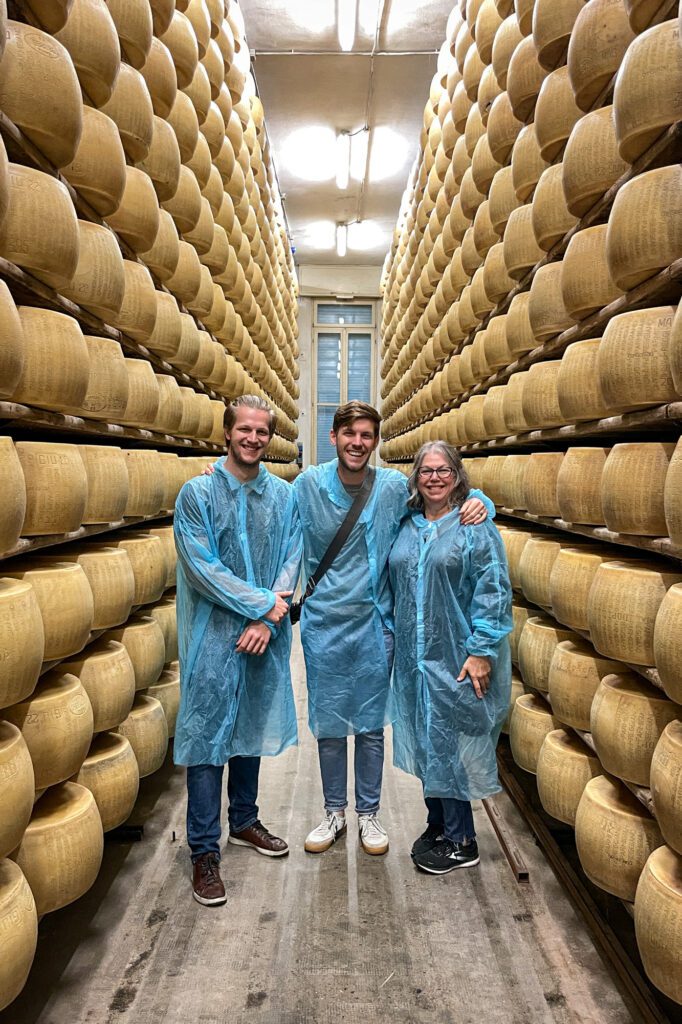
That tour is a morning tour, going until roughly noon.
We’d then spend the rest of the day in Modena, which is the capital of balsamic vinegar production and is an easy 20 minute ride from the train station in Reggio-Emilia (where you’ll get dropped off by Claudio). That’s what we did.
We loved tasting small production balsamic vinegar at La Consorteria 1966 (you should know that the tasting costs money unless you buy a bottle afterwards, which are expensive because this is the good stuff).
We also had multiple people recommend Osteria Francescana, which is a world-famous fine dining experience that you’ll need to book well in advance.
You can also try chef Massimo’s food at nearby Franceschetta58, which is less expensive and more approachable (you still want a reservation, though!).
Another great stop is the Mercato Storico Albinelli, which is Modena’s central market.
Add Another Day Trip from Florence
The second thing we’d add is an additional day trip from Florence. We gave you three options above, and if you took our advice, you’ve already done one of them. Do a second (or third!) one if you have an extra day.
Cinque Terre (2-3 Days)
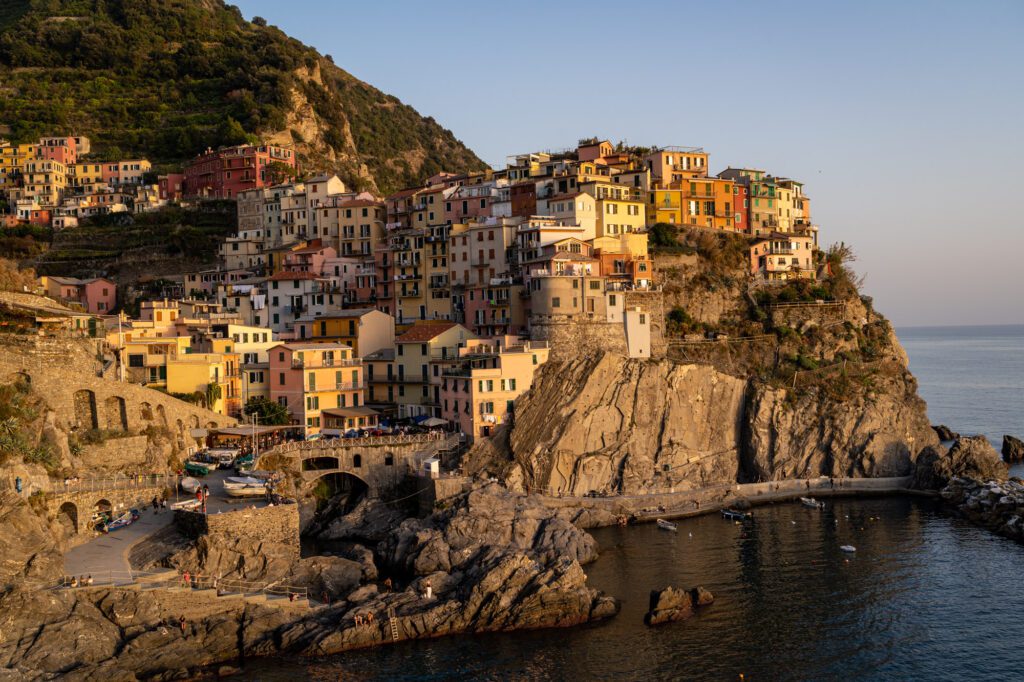
For my mom’s 60th birthday, we took her on a two week trip around Italy. Her two must-do experiences were the Cinque Terre and seeing the Last Supper in Milan.
So, we spent a few days exploring the Cinque Terre, and we loved it.
However, we have a major caveat. We would absolutely NOT recommend a day trip to the Cinque Terre, which is what approximately 90% of people seemed to be doing.
The main reason is that it’s a long way from places like Florence and Milan, requiring three hours of travel time.
That means you won’t arrive until mid-morning, which is when all of the other day trippers arrive, and the streets and trails are packed wall-to-wall. It’s no wonder people say it’s too crowded!
The magic of the Cinque Terre is in the early morning and late evening, when the day trippers clear out and it becomes a tranquil, slow paced coastal retreat. That means you’ll need at least one night (two or more is better).
The Cinque Terre, which literally means “Five Towns,” is a series of charming towns tucked between the mountains and the coast in northern Italy.
It’s known for hiking, terraced vineyards, and colorful towns perched on rocky outcroppings above the sea.
You’ll definitely want to hike a section of the Blue Trail (we like the one from Corniglia to Vernazza the most), dive into the wines of Cinque Terre, take in some excellent sunset views, and explore all five towns.
We have a bunch of guides dedicated to helping you plan your Cinque Terre trip. Here are some links for you:
Milan (2 Days)
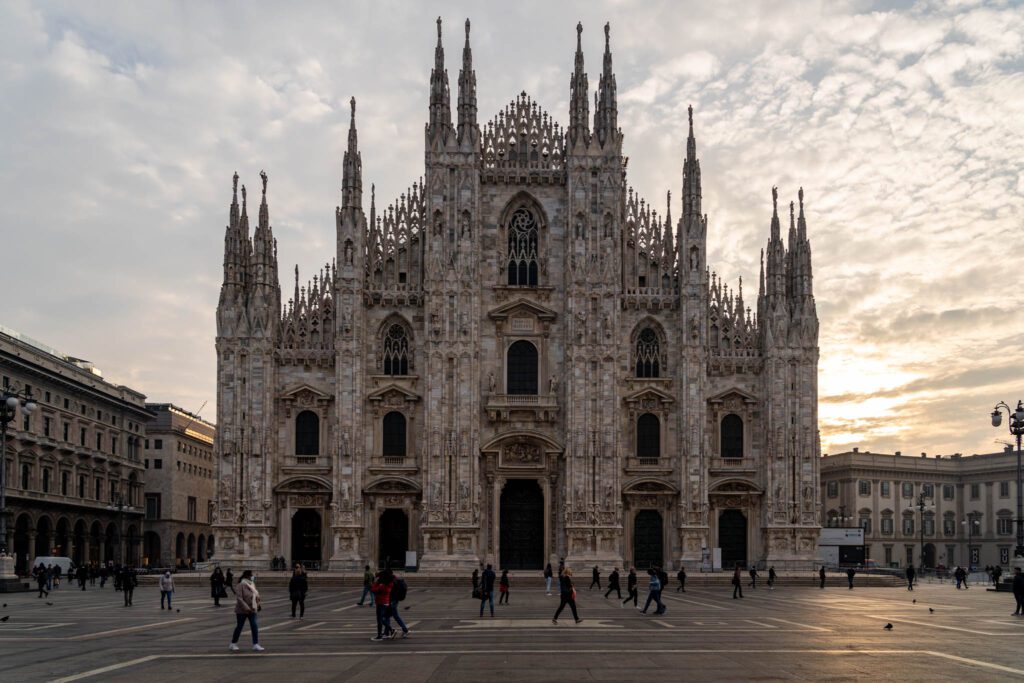
Milan is a really great city that offers something a little different from other major cities like Rome and Florence.
That’s not to say that it’s not a historic city, but it feels less “Italian” than Rome and Florence mostly because it has been trading hands between the Spanish, French, Italians, and Austrians for centuries.
There is a difference that you’ll notice right off the bat, probably when you exit the train station.
It looks and feels more modern, which is mostly a function of the fact that it’s a major financial hub and home to just about every high end fashion company in the country.
There are two world-class attractions in Milan – the Duomo di Milano which took 600 years to complete and is a mishmash of different styles that somehow still works, and Da Vinci’s Last Supper.
However, it’s worth lingering for an extra day to explore some of Milan’s less famous attractions and the hip food and drink scene.
Wander Parco Sempione and pop into Castelo Sforza, and experience aperitivo in the Navigli District, which is home to some of Milan’s last exposed canals (it used to look like Venice!).
Where to add it: You could either do Milan after Bologna (there’s a high speed train connecting the two), or after Venice (and fly out of Milan).
We have a bunch of guides dedicated to helping you plan a trip to Milan. Here are some links for you:
- One Day in Milan: The Best of Milan in a Day
- 2 Days in Milan: How to Plan An Incredible Milan Itinerary
- Where to Stay in Milan: A Complete Guide
- The Best Things to Do in Milan
- Where to Find the Best Specialty Coffee in Milan
- Gluten Free Milan: A Complete Guide for Celiacs
Sicily (7 Days)
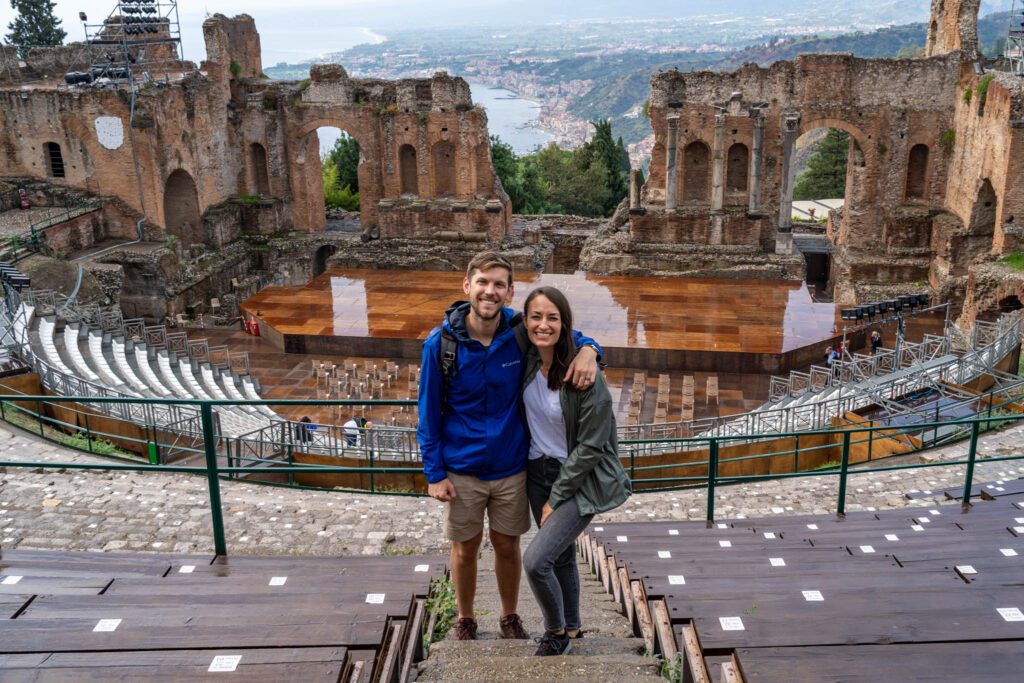
If you have about a full week of extra time, we’d highly recommend exploring Sicily.
We love Sicily (Alysha’s family is from a small town in southeast Sicily), and spent three weeks on the island in the fall (which somehow was still not enough time).
However, you should know that Sicily is massive, and it’s impossible to do the entire island in a week.
For that reason, we’d focus on southeastern Sicily (Catania, Mount Etna, and Syracuse). Unfortunately, that means you’ll miss Palermo, which is an amazing city in northwestern Sicily.
The other reason to focus on southeastern Sicily is that you don’t need to rent a car. The corridor from Taormina to Syracuse is connected by a regional train line, which is something that can’t necessarily be said for the rest of the island.
To get there, you’ll need to fly. The best place to fly into is Catania (Catania–Fontanarossa Airport).
Definitely don’t miss a day trip from Catania up to Mount Etna, which was among the highlights of our trip (you can read about it in our guide to the best things to do in Catania) and a trip to the amphitheater in Taormina, which has a spectacular view.
Oh, and eat all of the pistachio and almond granitas you can.
We have an entire guide dedicated to helping you plan a Sicily itinerary, which has a couple of ideas for how to spend 7 days on the island (P.S. we recently wrote a specific guide for spending 7 days in Sicily, which is even more helpful and specific in this context).
Where to add it: We’d add it after Venice, flying from Venice to Catania (which might require a connection) and flying home from Catania.
What to Do with Less Time in Italy
We’re not going to dive deep into how to spend less time in Italy, mostly because we’ve already done exactly that in some of our other guides.
We have a guide to 10 days in Italy that’s geared towards first-timers that focuses on Rome, Florence, and Venice, and how to make the most out of your time in those places.
We also have a guide to spending 7 days in Italy, which is a little different because it gives a bunch of different ways to do a weeklong trip to Italy.
If you’re looking for ideas for a shorter trip, definitely read those.
Planning a trip to Italy? We’d love to help!
Here are our other Italy travel guides to help you plan an incredible trip (even if you have to eat gluten free!).
If there’s no link below, it means we’re still working on it – long, in-depth guides take time! We’re working on it, though, we promise.
If you’re planning a trip and you’re not sure where to start, your first stop should probably be one of our detailed itineraries.
We have a two week Italy itinerary that blends the main cities with some less-visited cities that we love (BOLOGNA!), a guide to spending 10 days in Italy that focuses mostly on the highlights, and a whirlwind guide to spending one week in Italy that features the Rome – Florence – Venice highlight circuit.
We also have a guide covering important tips for traveling to Italy for the first time, which is a collection of things we’ve learned over the course of our time in Italy that will help you have a smoother, more immersive trip.
Here are more specific guides to the main cities in Italy.
Rome
- What to do in Rome (as a First Timer)
- How to Plan an Amazing 4 Day Rome Itinerary
- Where to Stay in Rome: A Complete Guide for First Timers
- 26 Things to Know Before You Visit Rome
- Gluten Free Rome: A Complete Guide to GF Restaurants + Bakeries
- Where to Find the Best Specialty Coffee in Rome
Florence
- What to do in Florence (as a First Timer)
- How to Plan an Amazing Florence Itinerary (3 Days)
- Where to Stay in Florence: A Complete Guide for First Timers
- Gluten Free Florence: A Complete Guide to GF Restaurants + Bakeries
- Where to Find the Best Specialty Coffee in Florence (for Coffee Nerds)
- The Best Day Trips from Florence (Complete Planning Guide)
Venice
- A Perfect 3 Day Venice Itinerary (for First Timers)
- Exactly What to Do in Venice (As a First Timer)
- Where to Stay in Venice: A Complete Guide
- Gluten Free Venice: A Complete Guide (for Foodies)
Bologna
- What to do in Bologna (as a First Timer)
- How to Spend One Incredible Day in Bologna
- How to Plan an Amazing Bologna Itinerary (2 Days)
- Where to Stay in Bologna: A Complete Guide for First Timers
Cinque Terre
- What to do in Cinque Terre (as a First Timer)
- How to Plan an Amazing Cinque Terre Itinerary (2 Days)
- Where to Stay in Cinque Terre: A Complete Guide for First Timers
Milan
- What to do in Milan (as a First Timer)
- How to Plan an Amazing Milan Itinerary (2 Days)
- Where to Stay in Milan: A Complete Guide for First Timers
- Gluten Free Milan: A Complete Guide to GF Restaurants + Bakeries
The Rest of Italy
